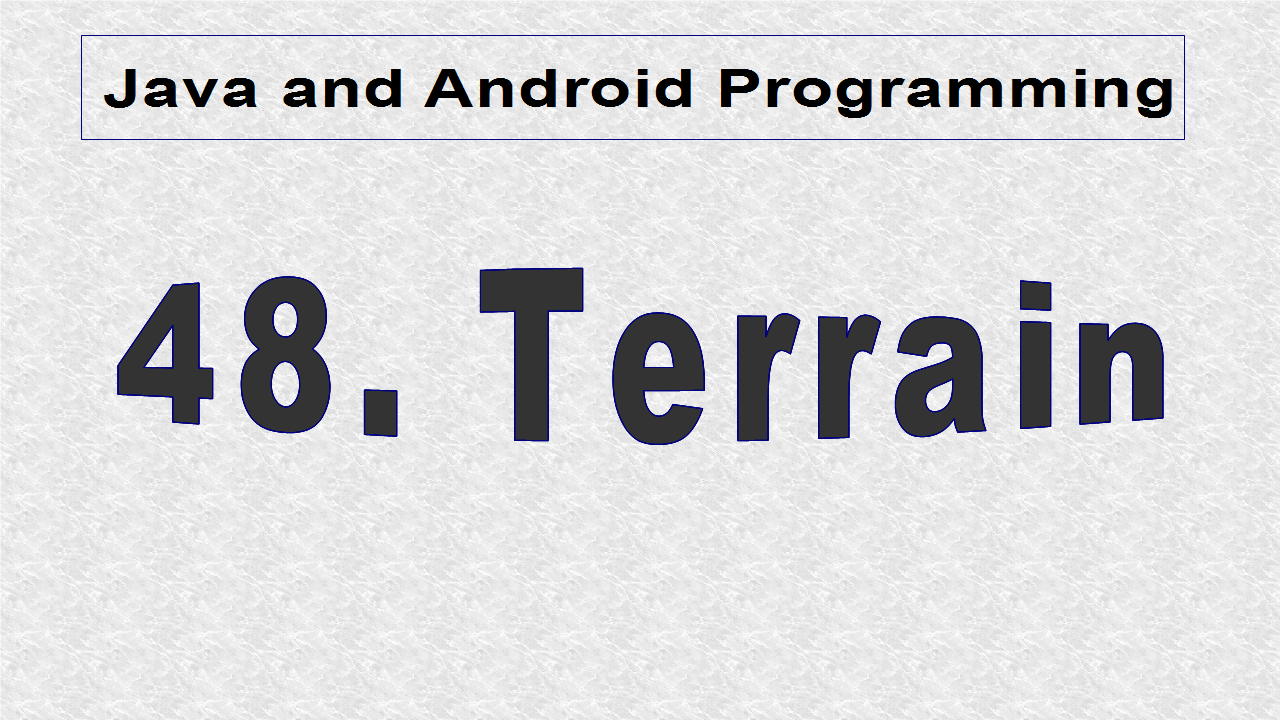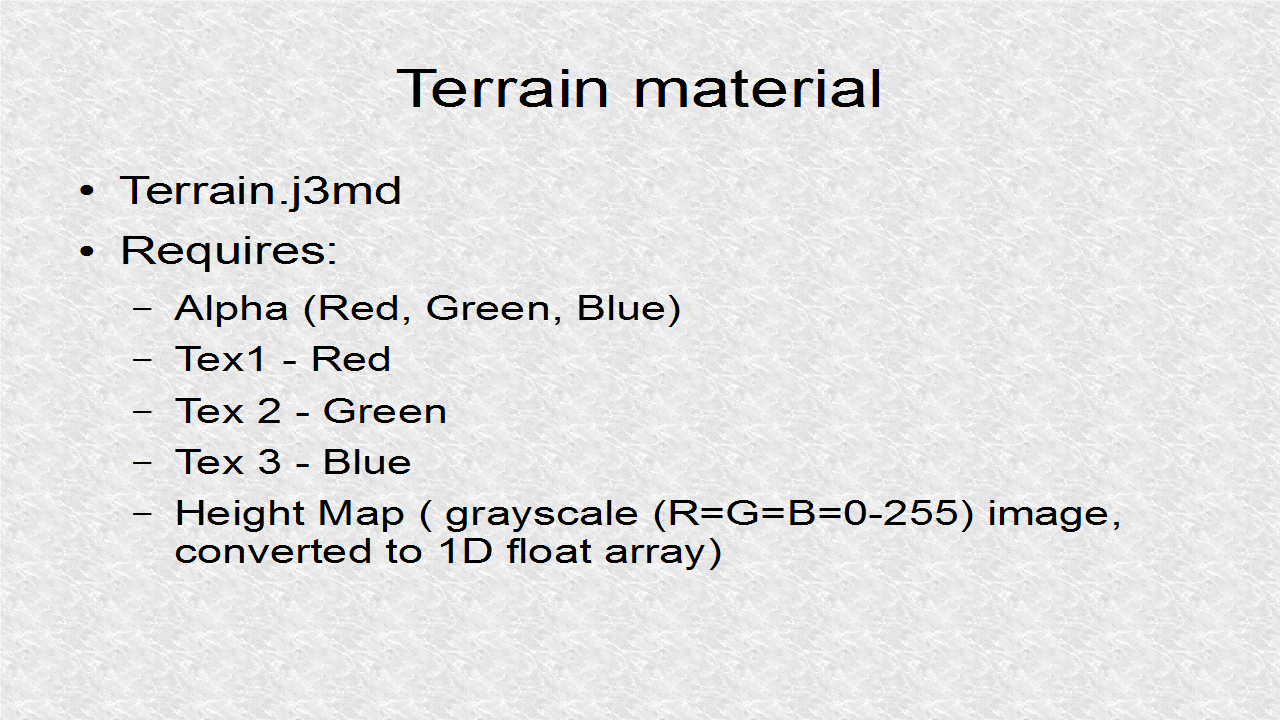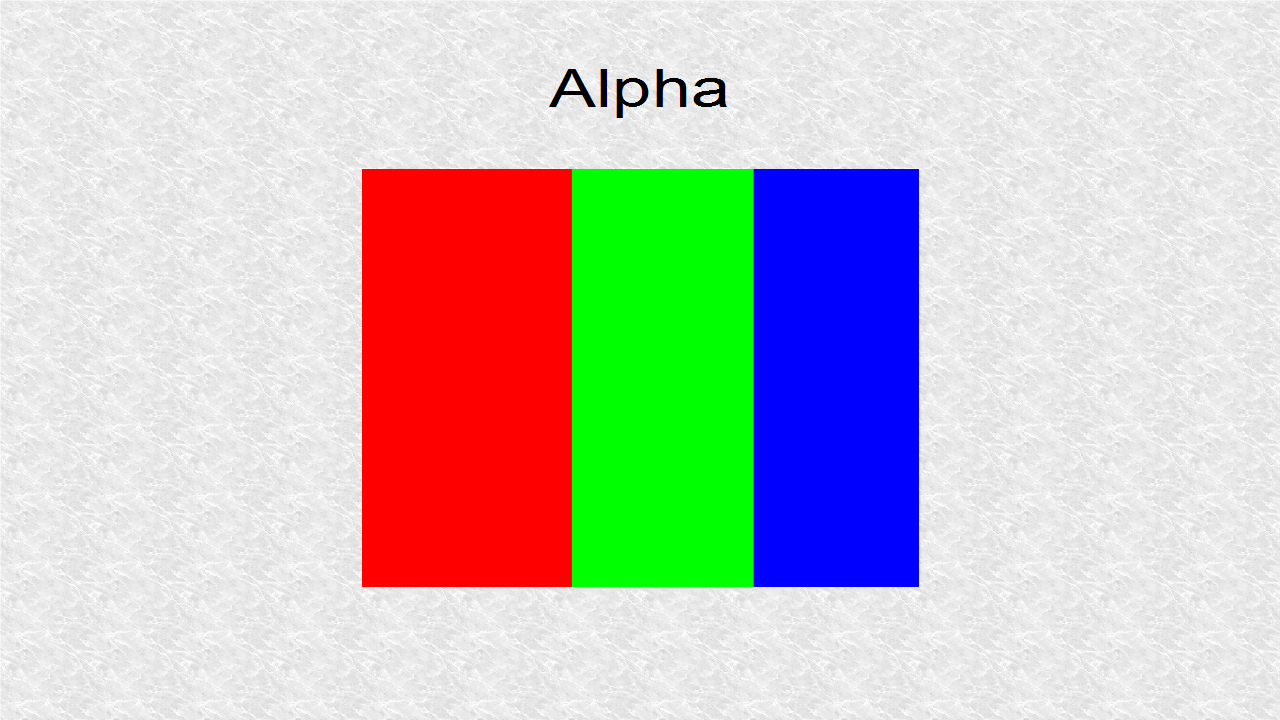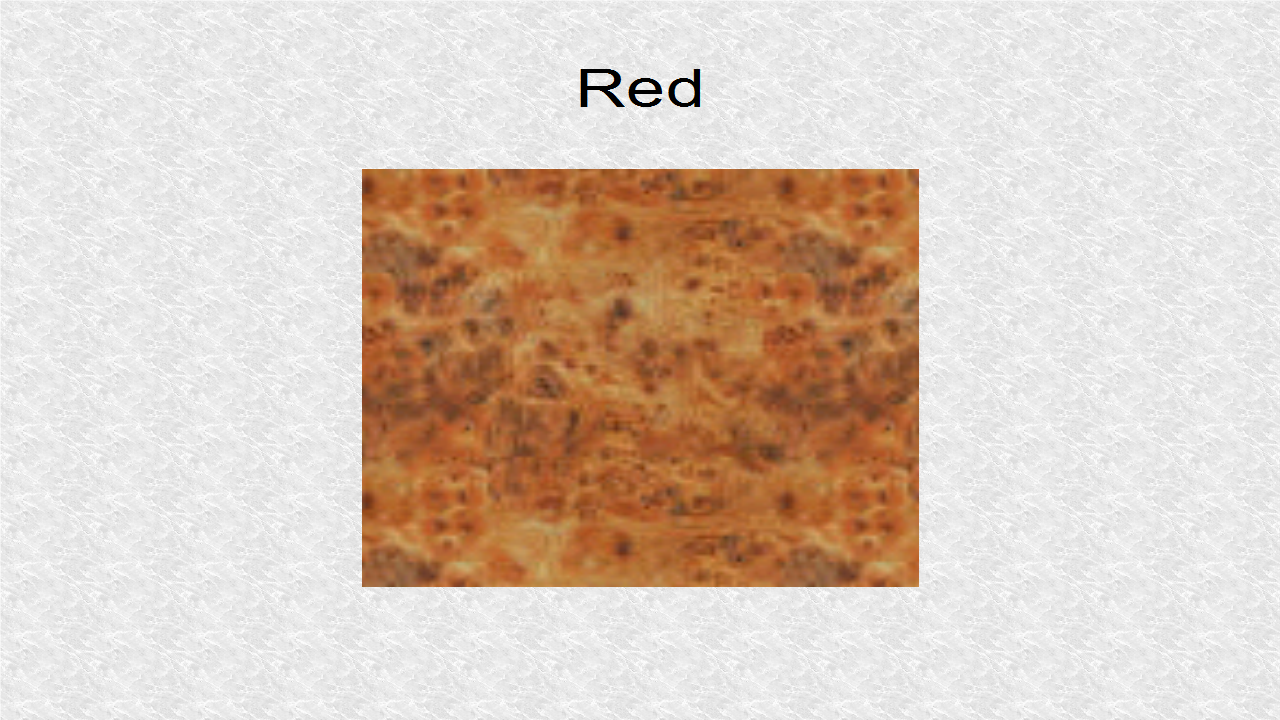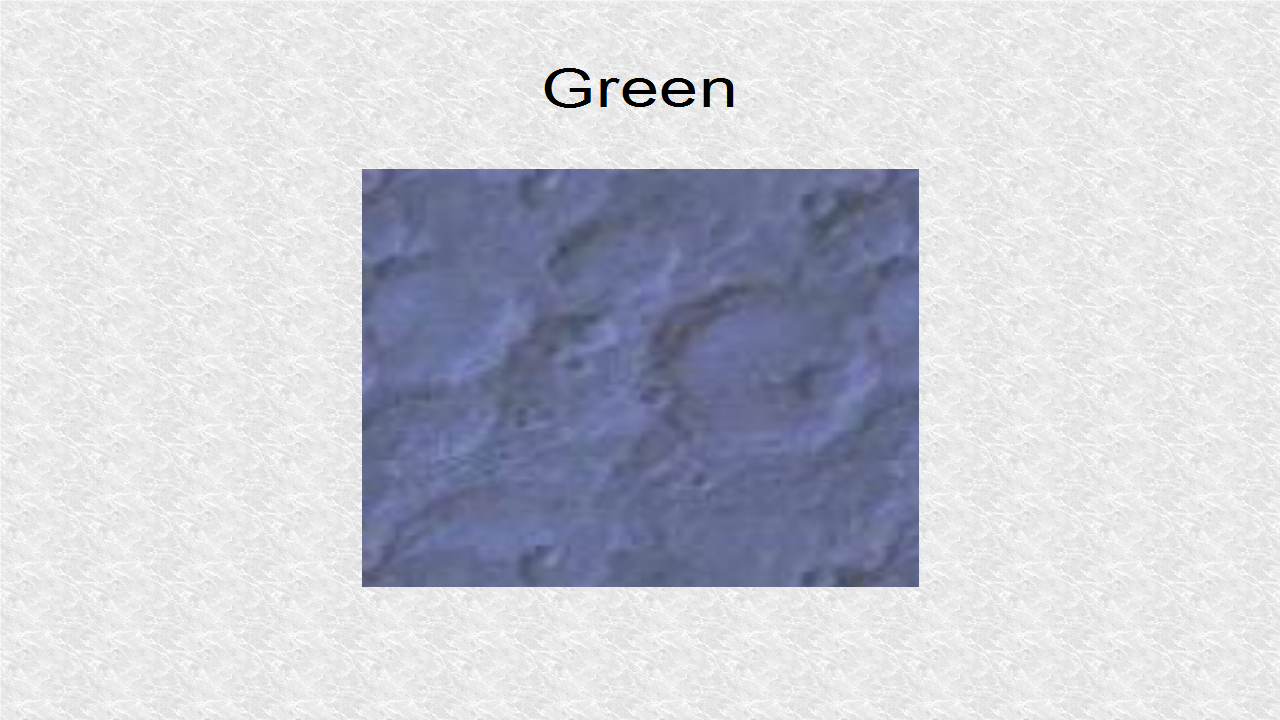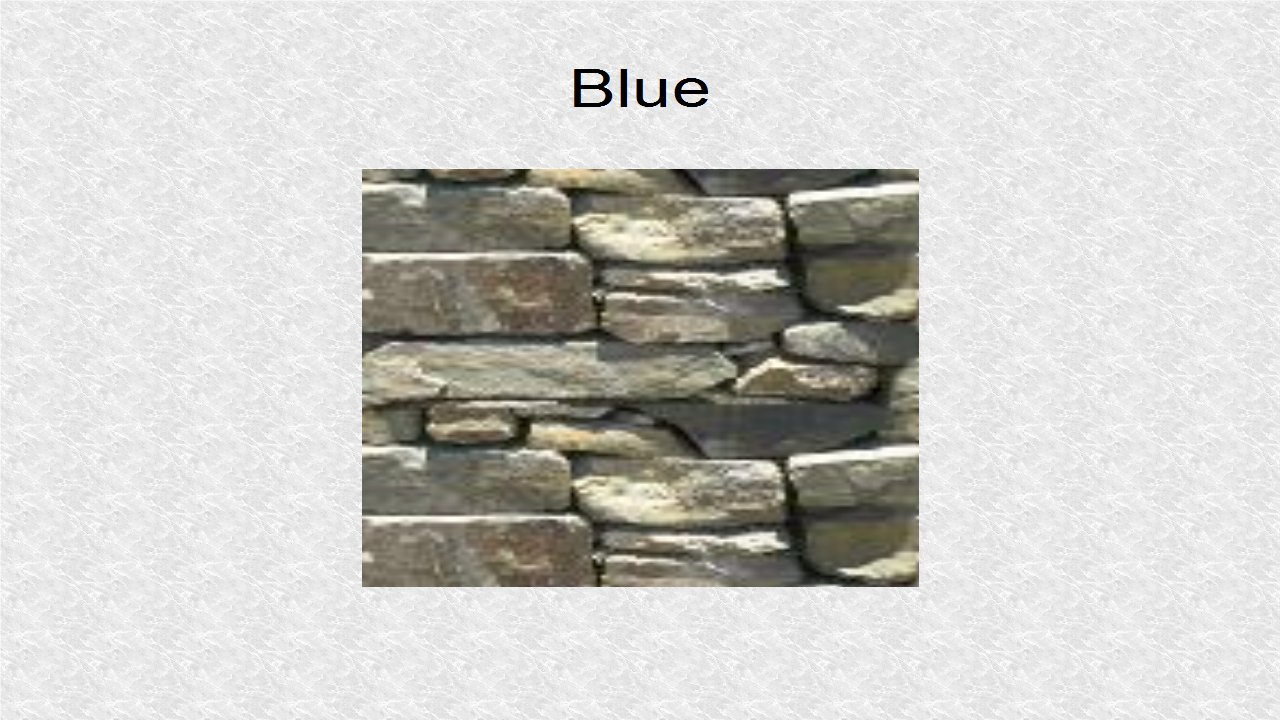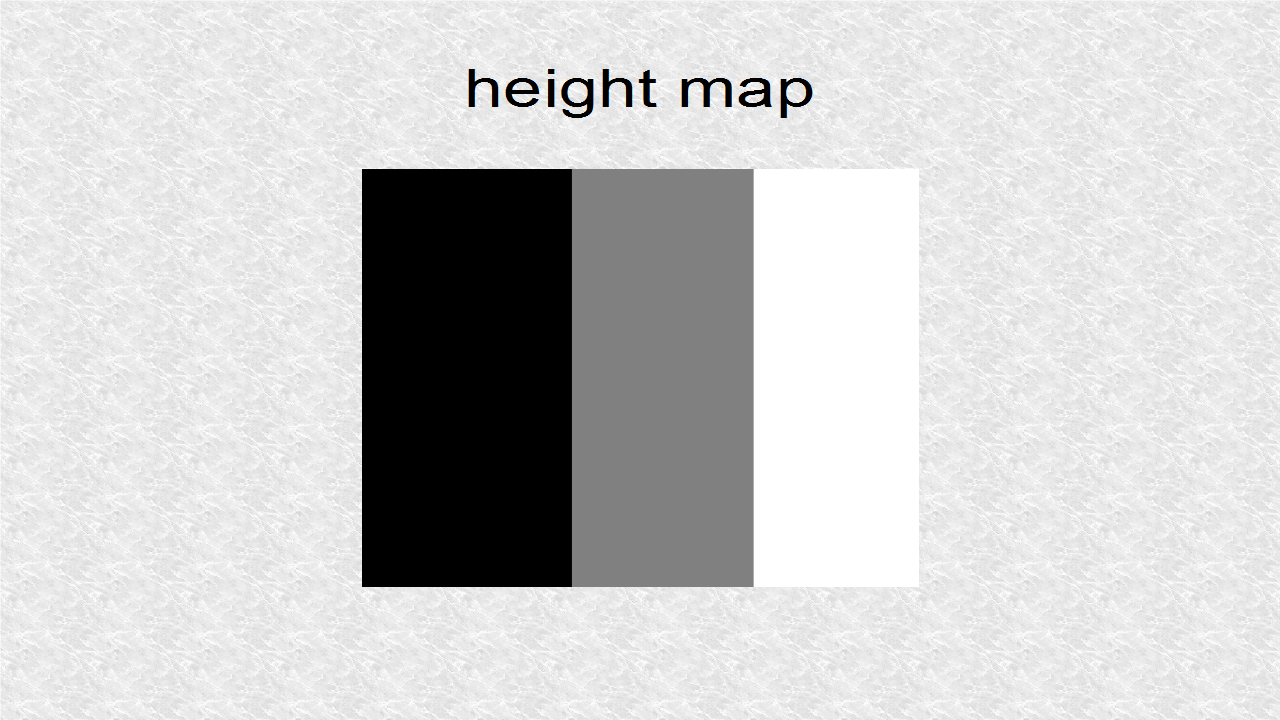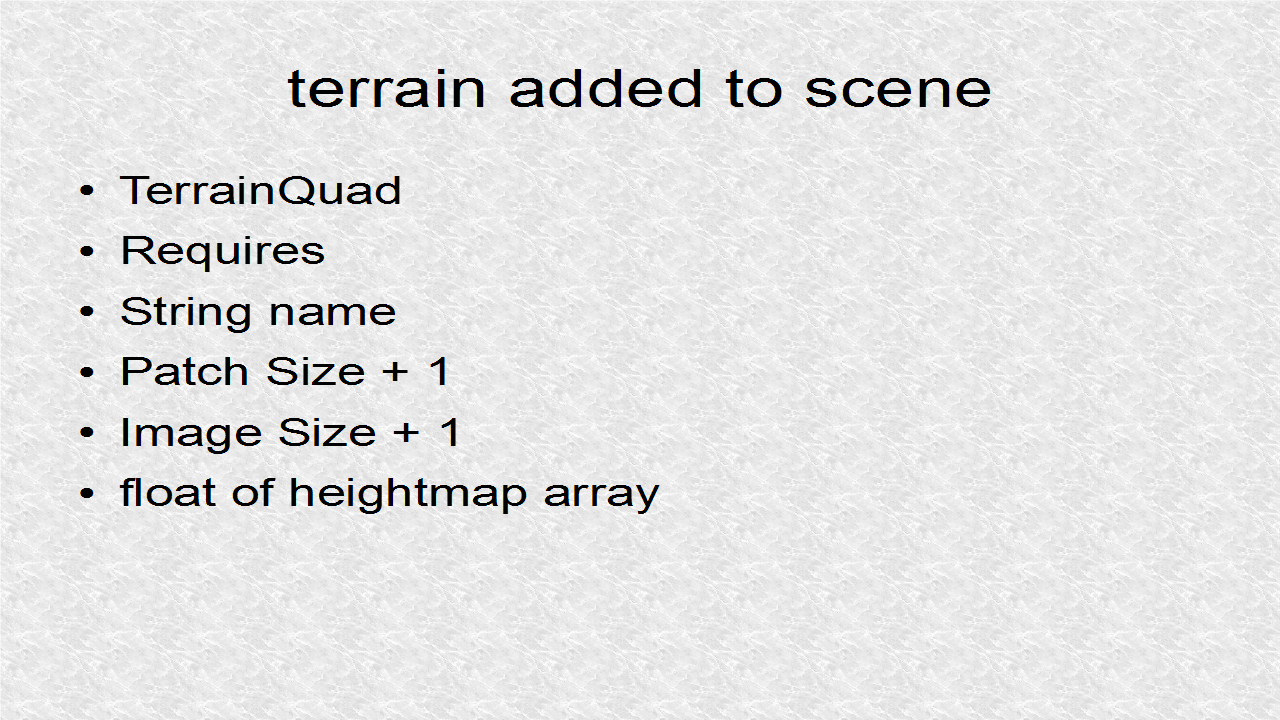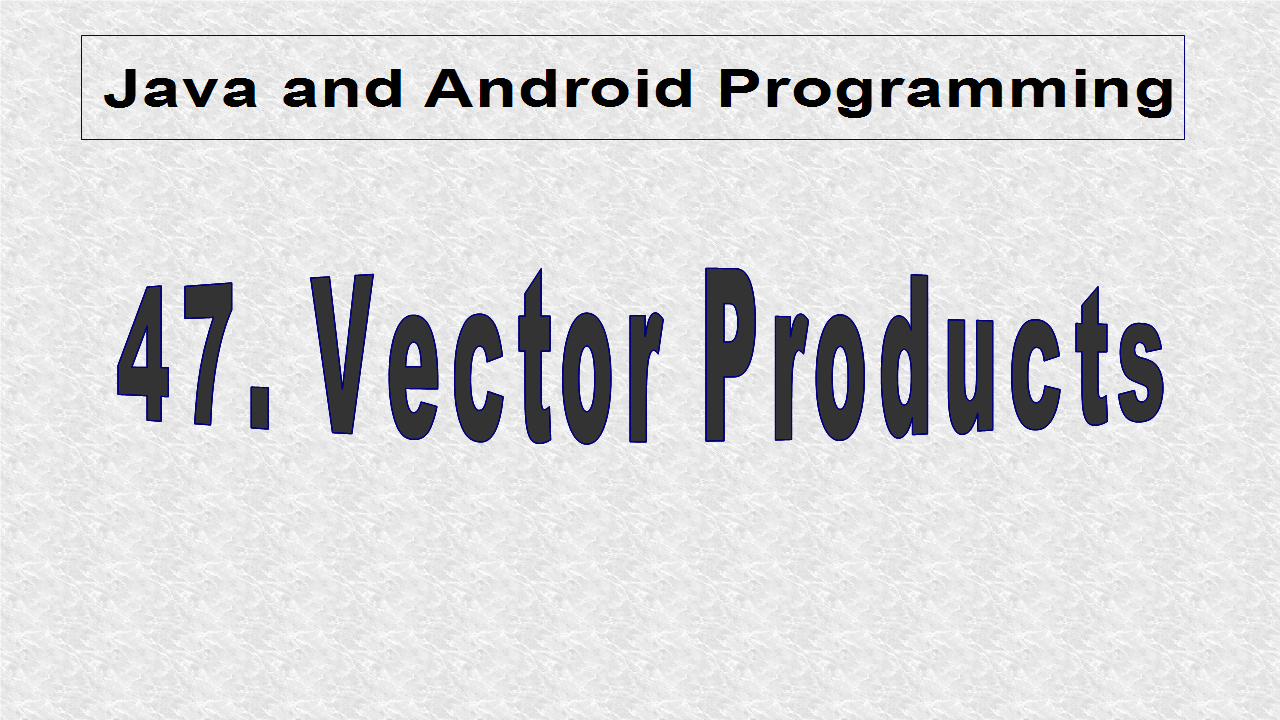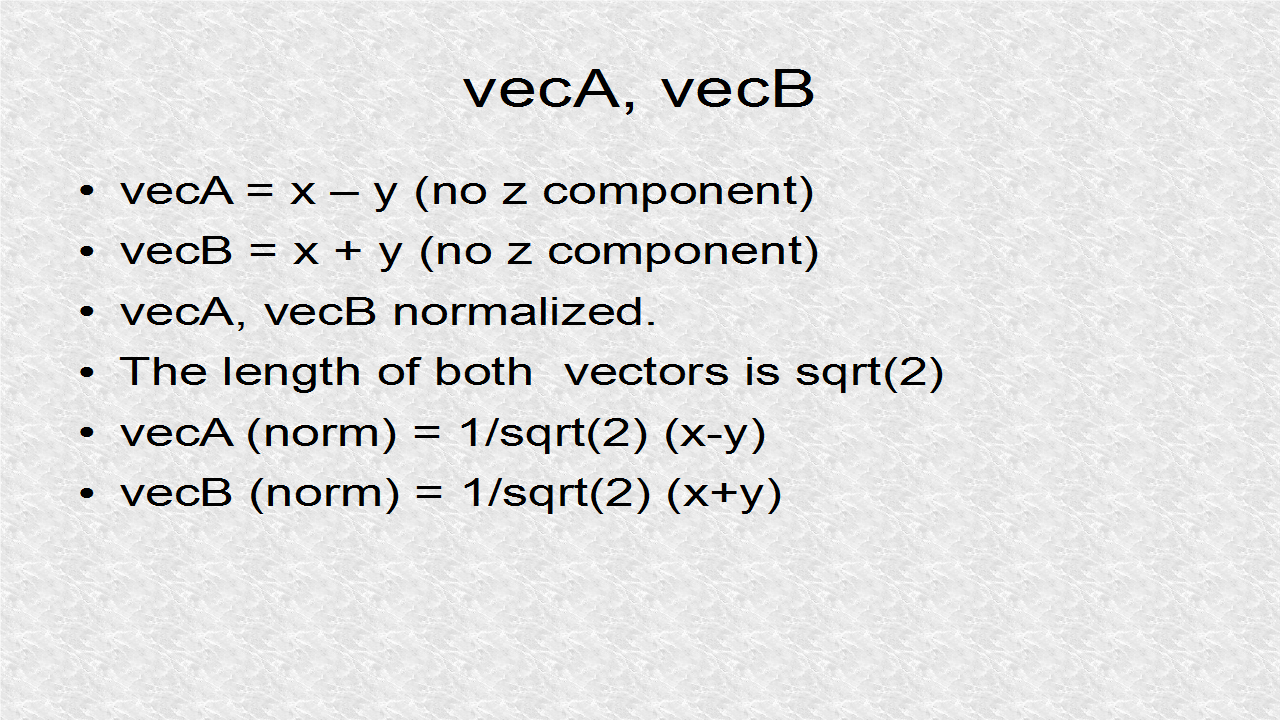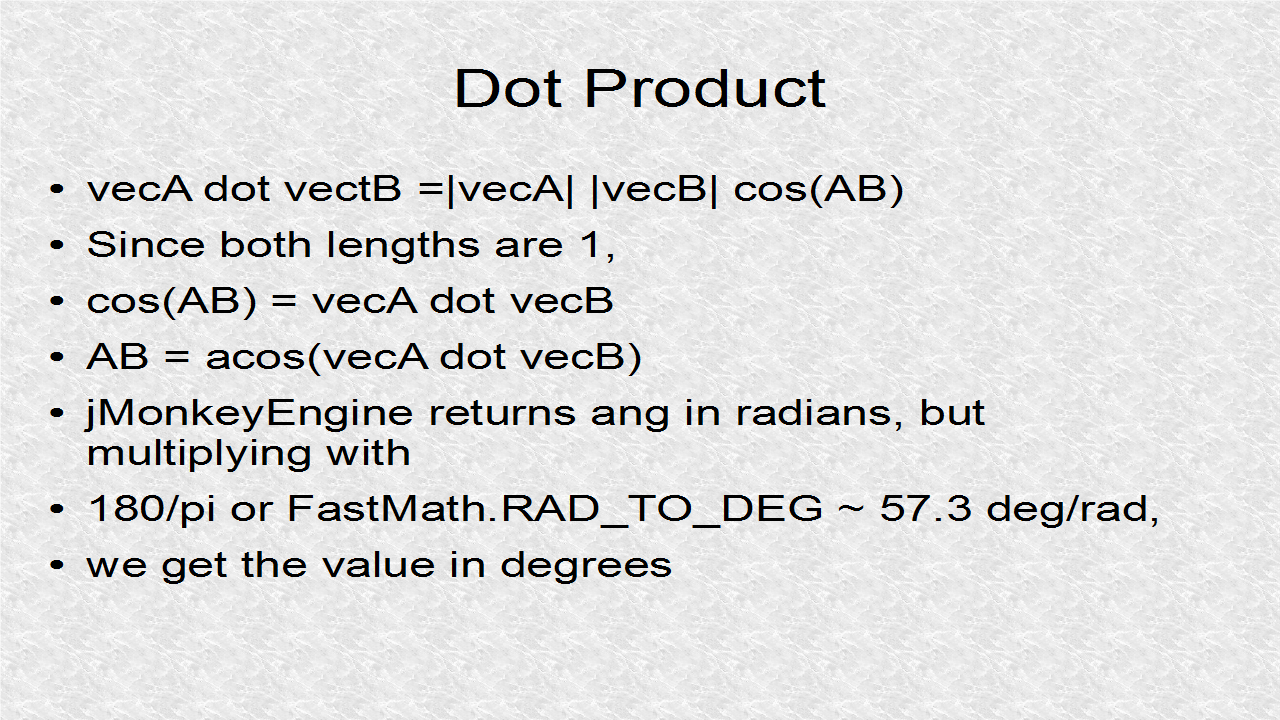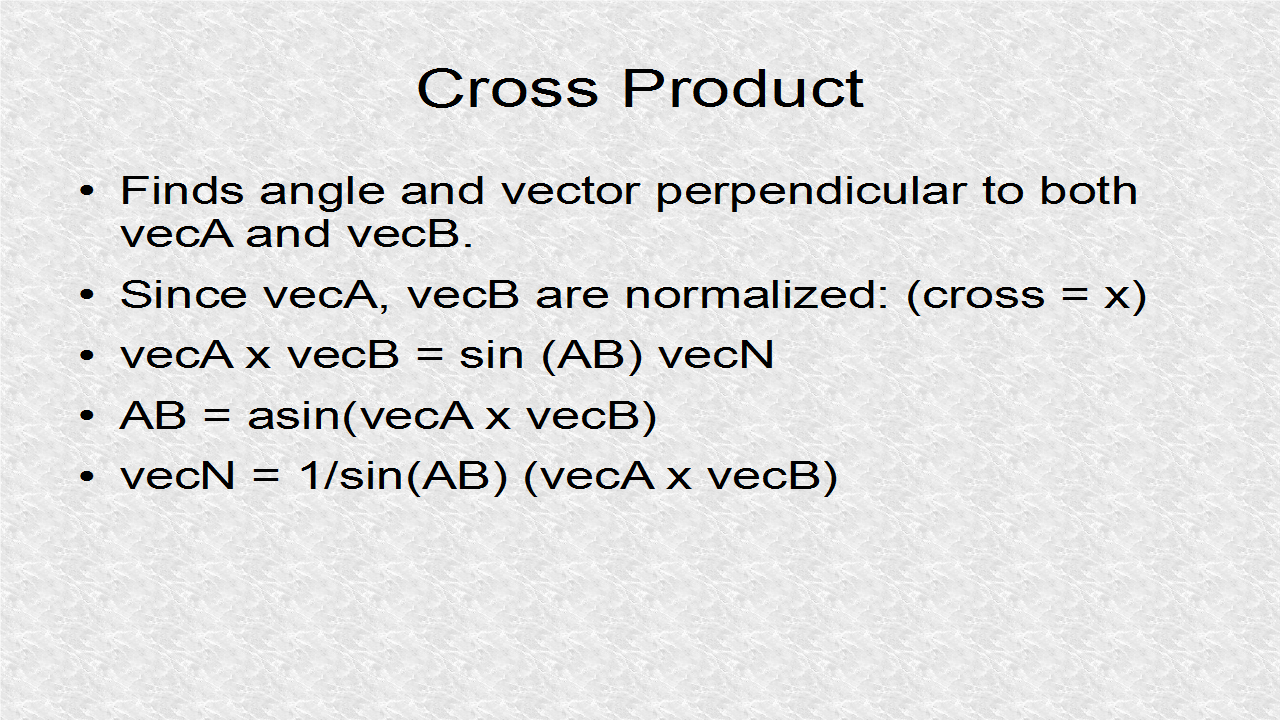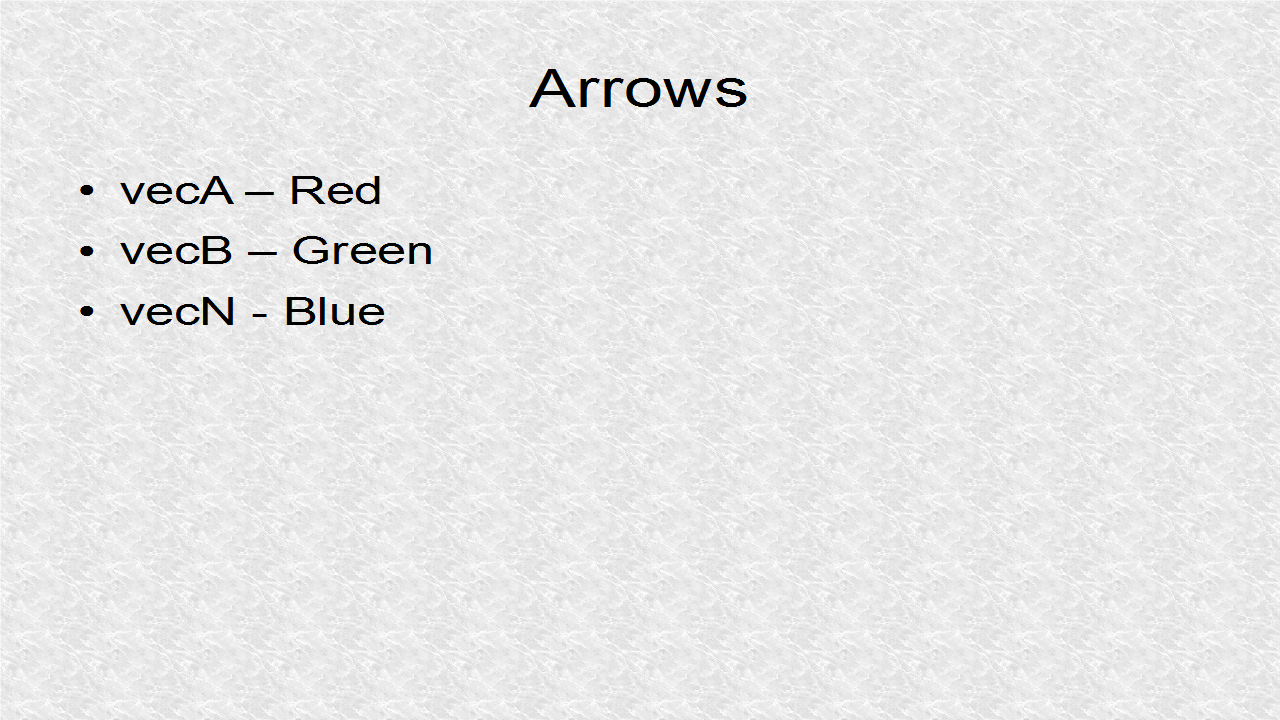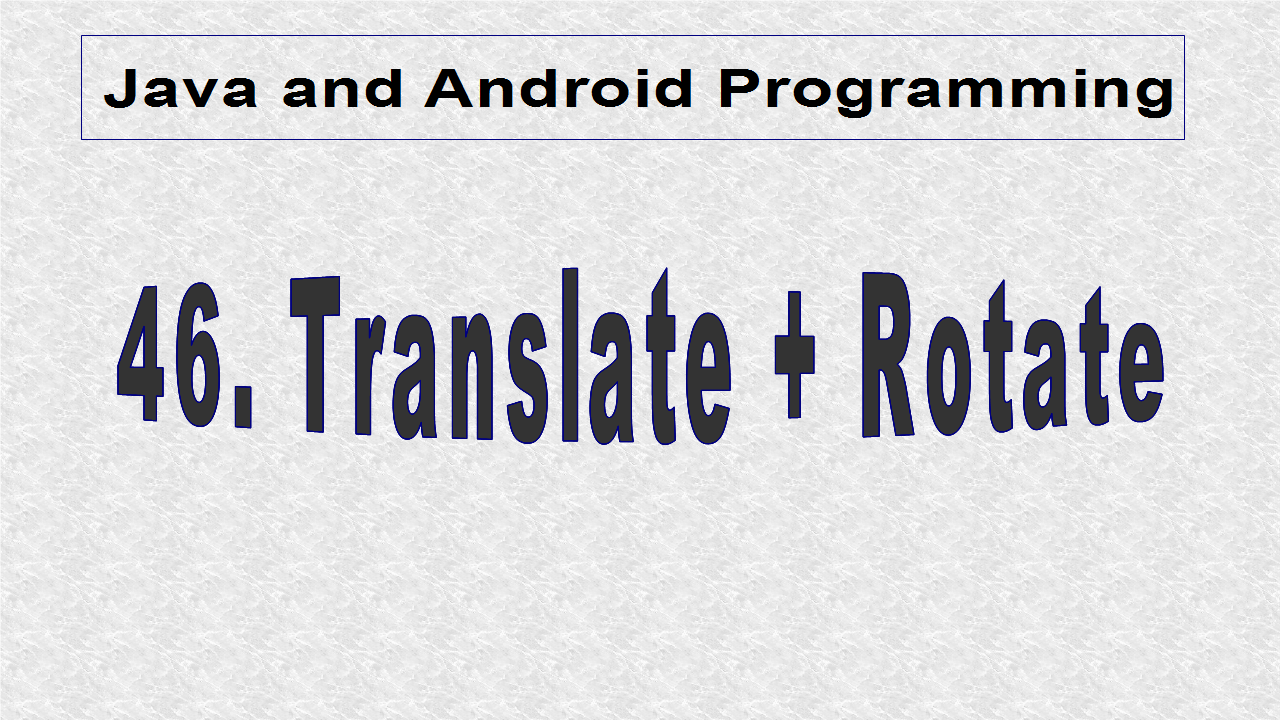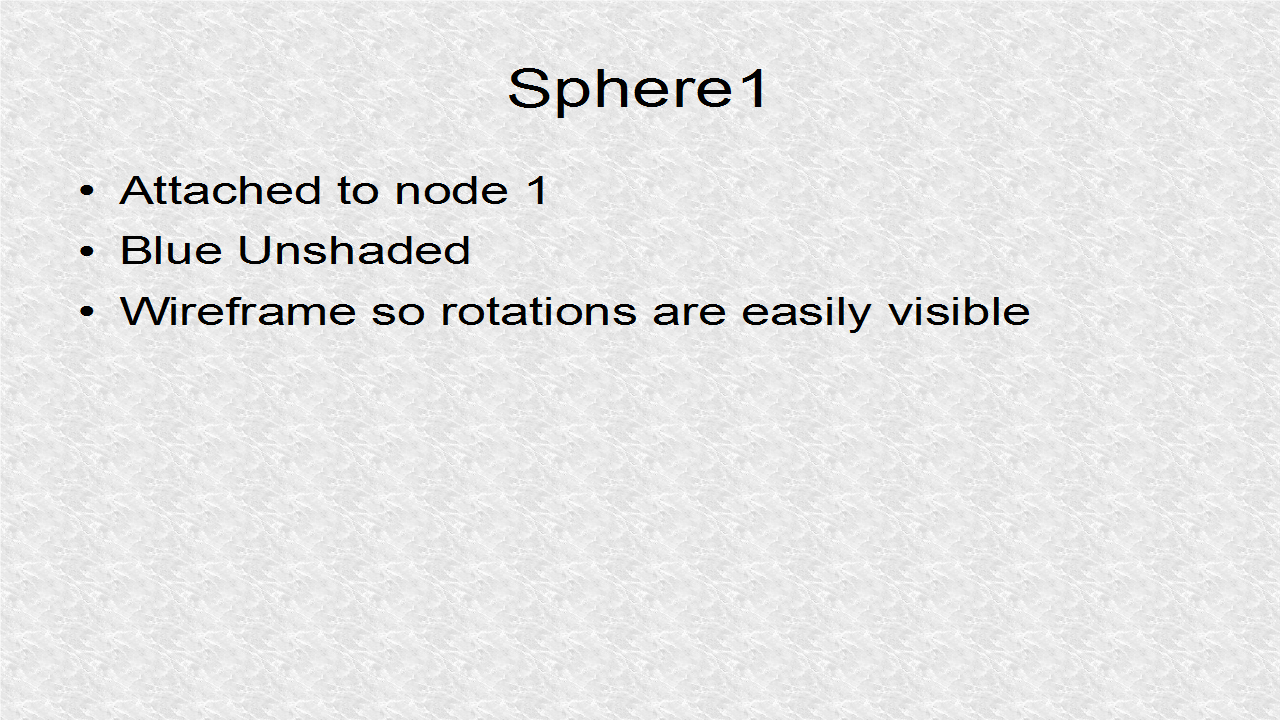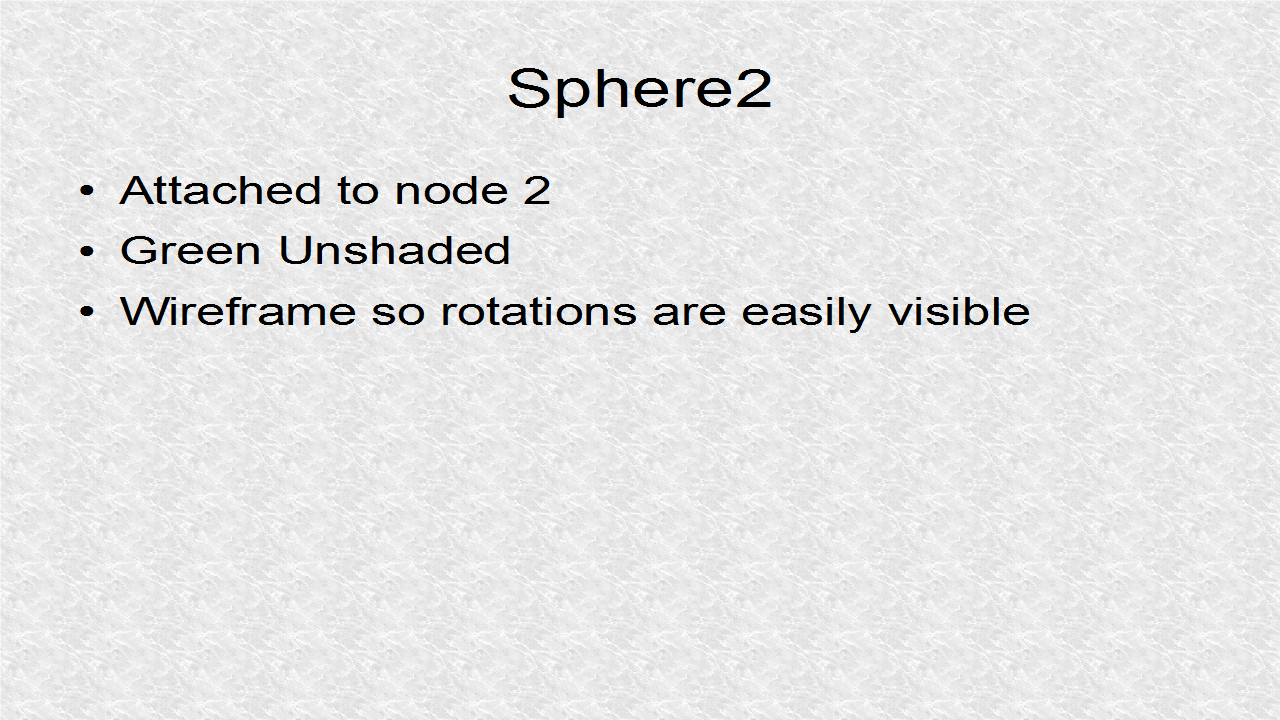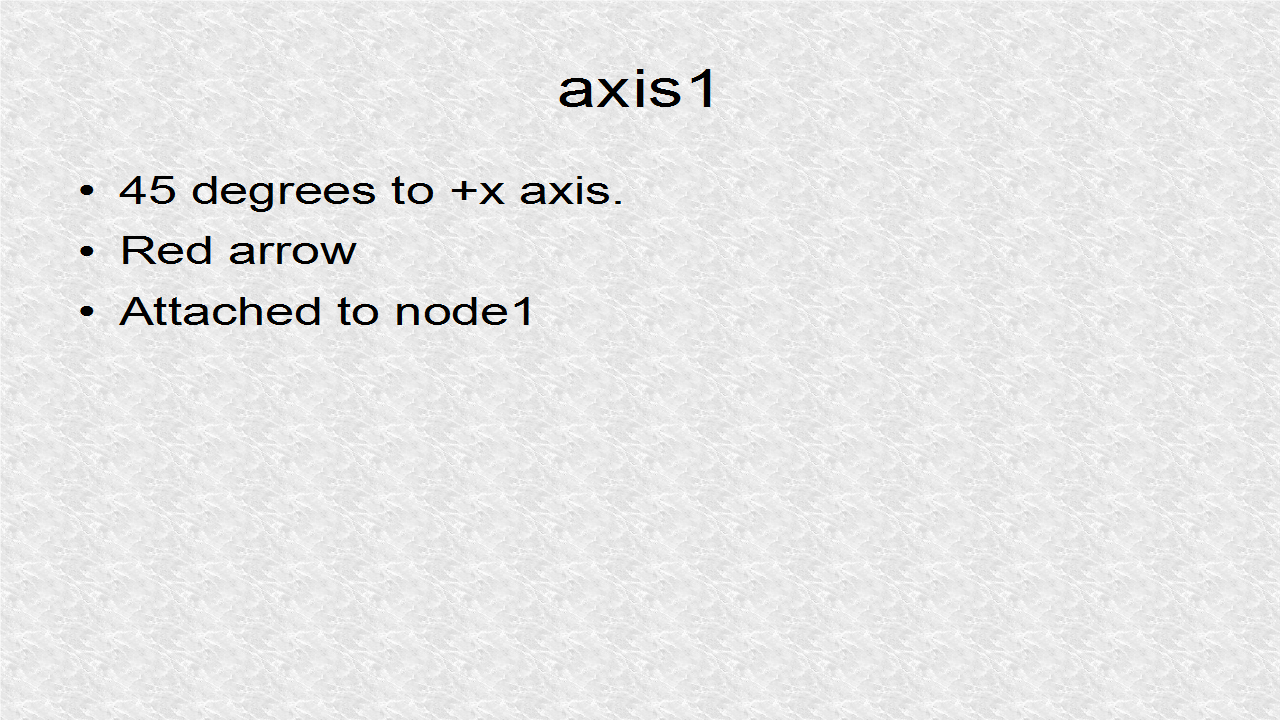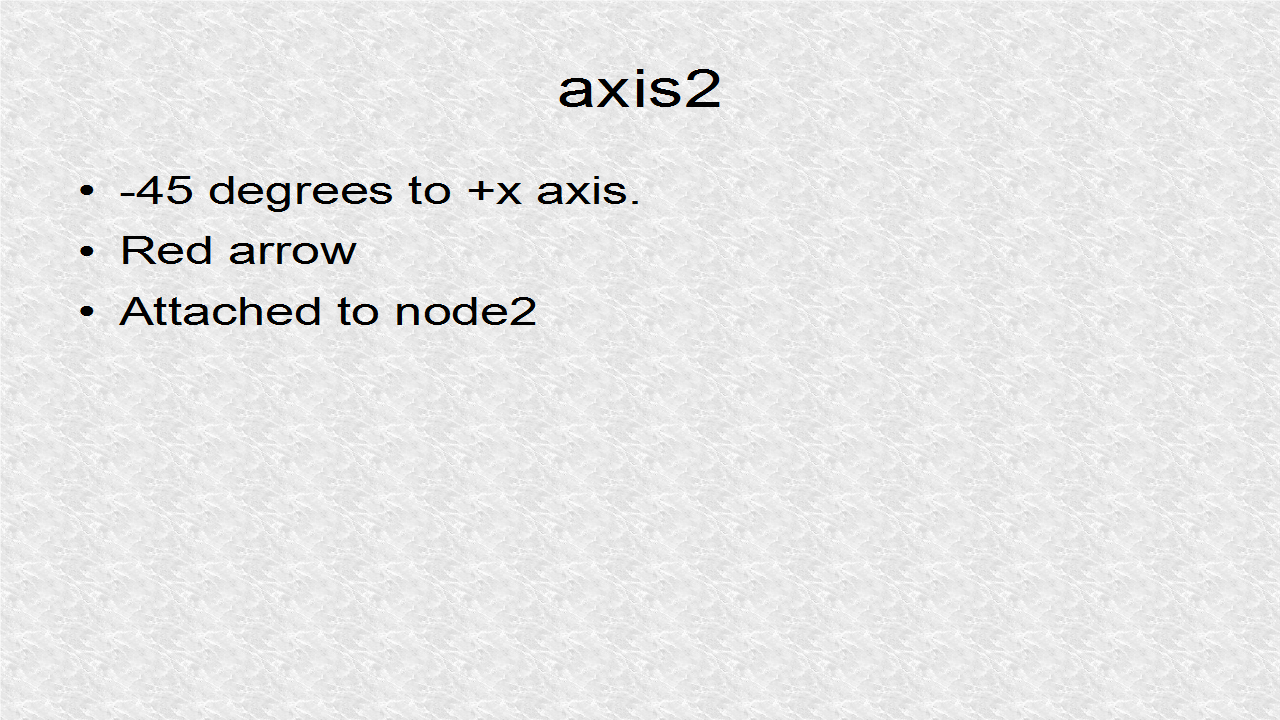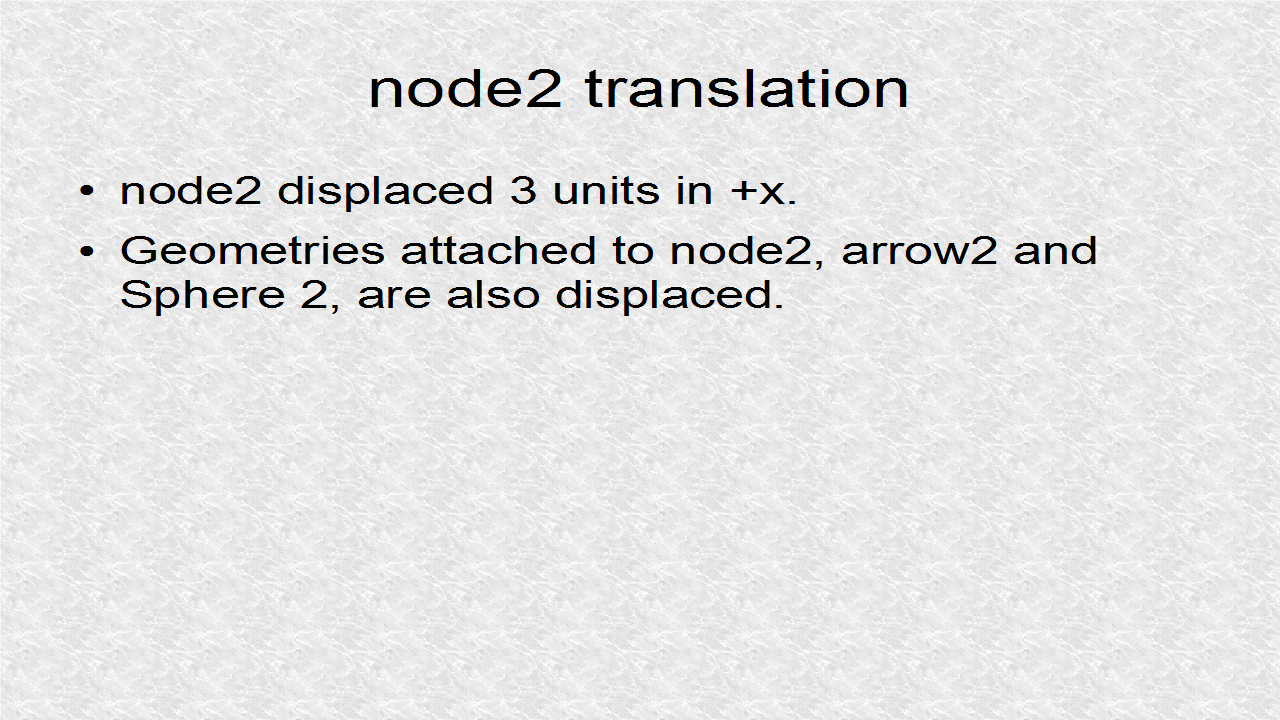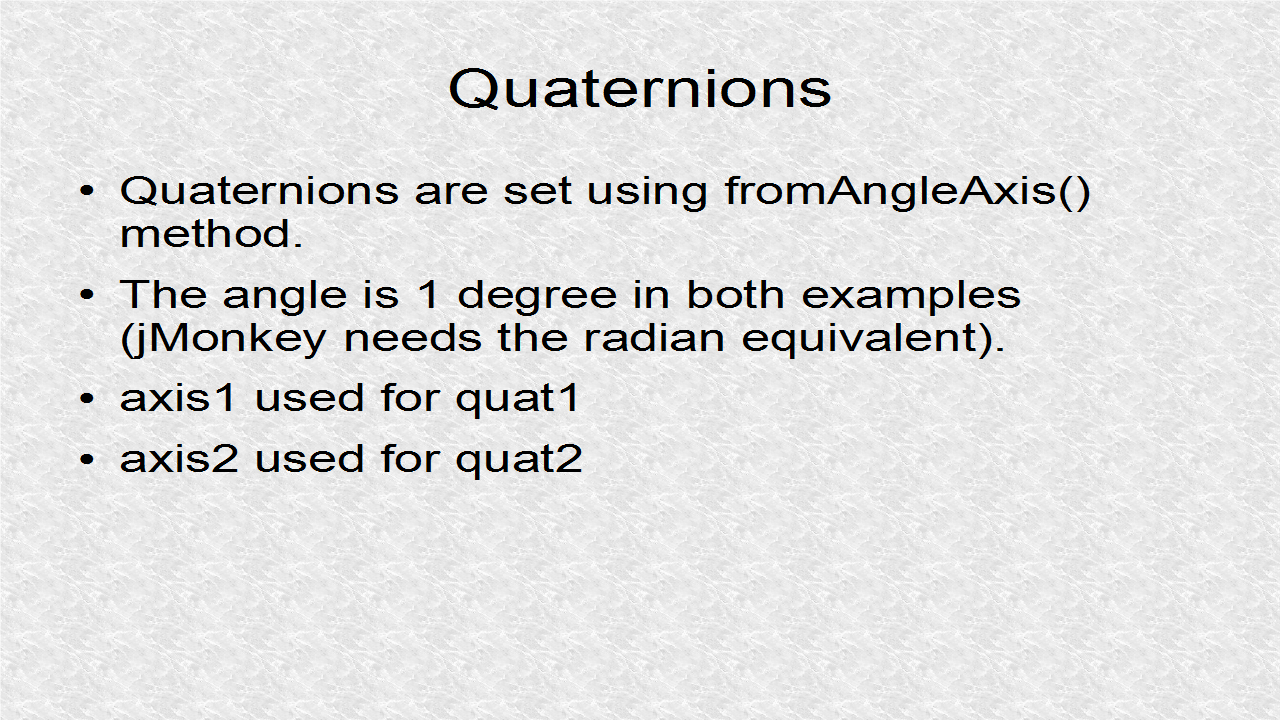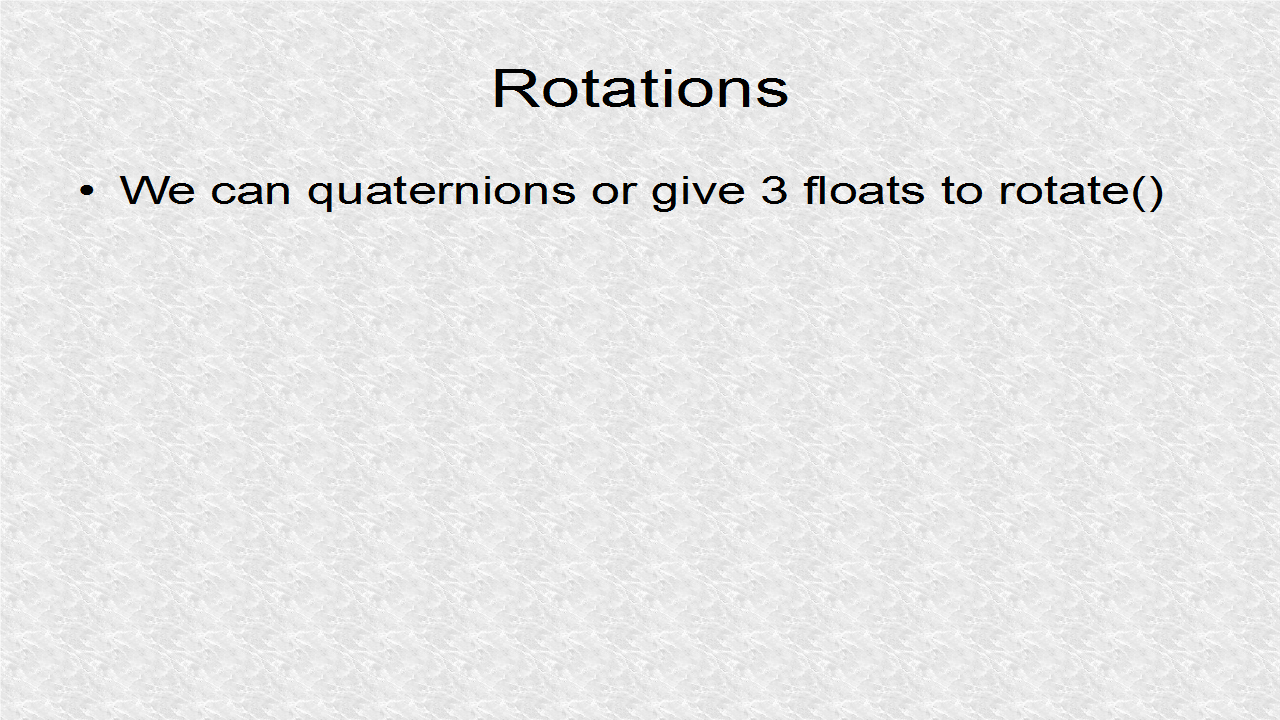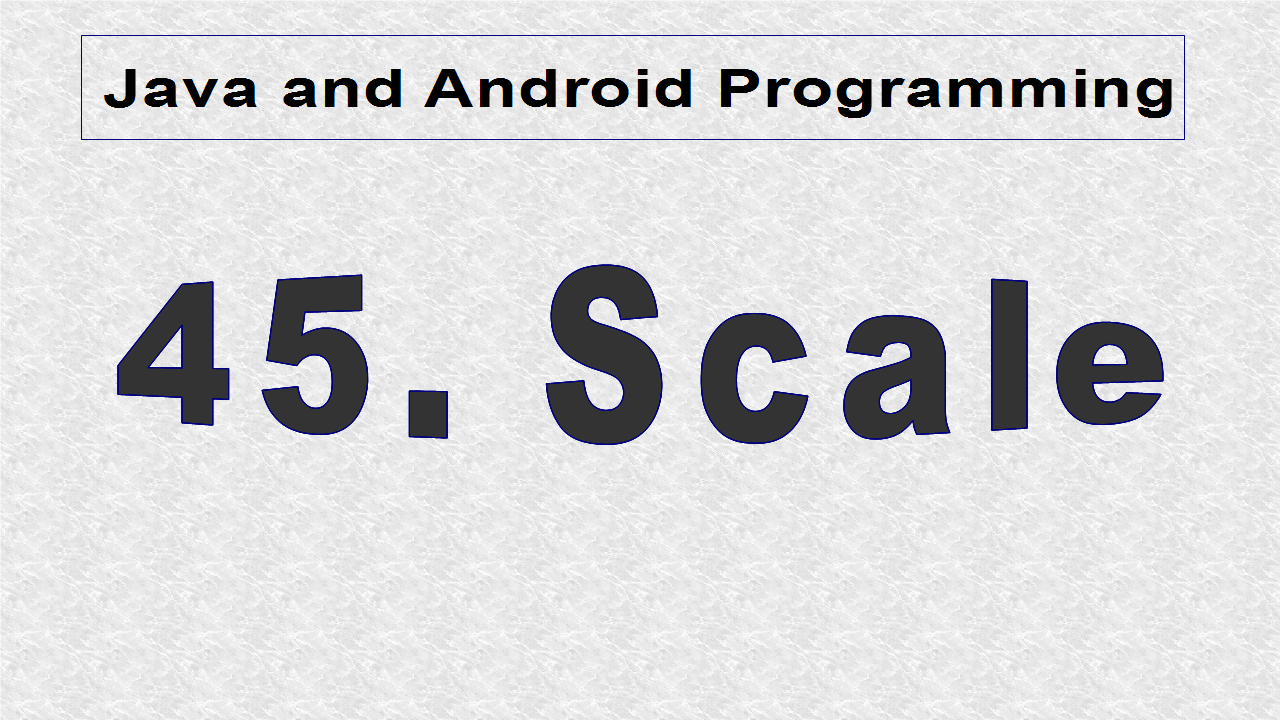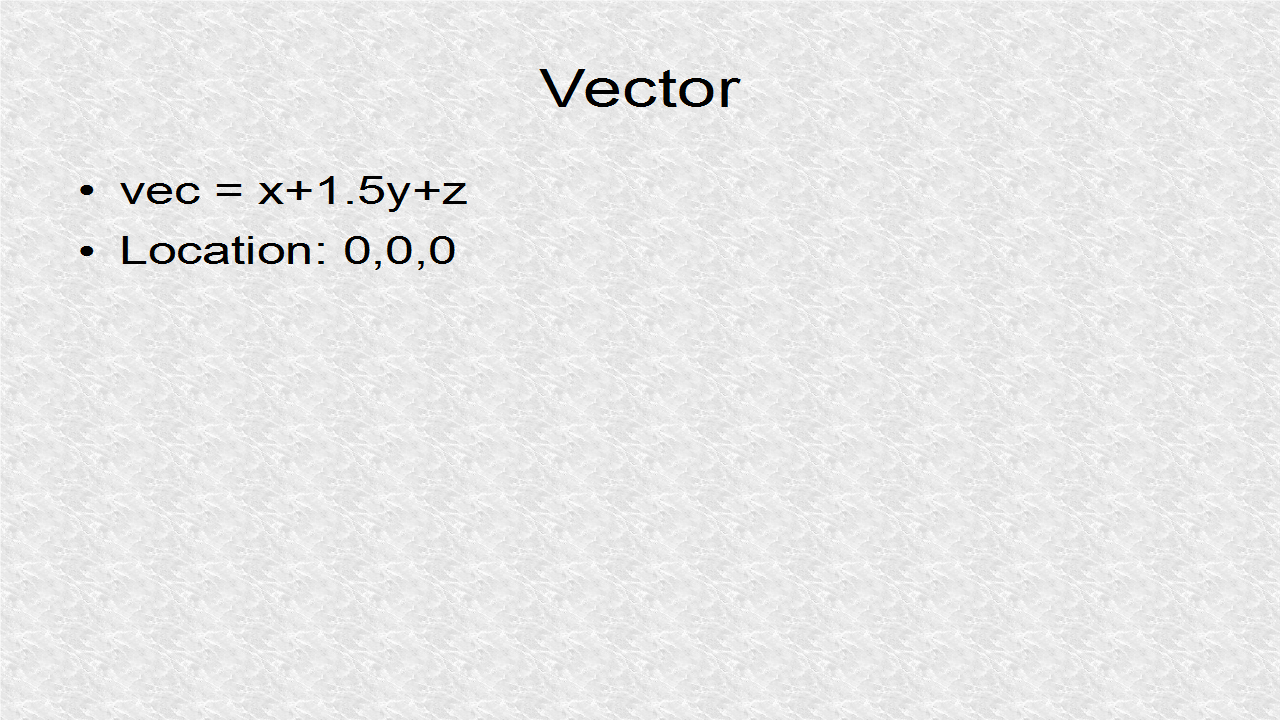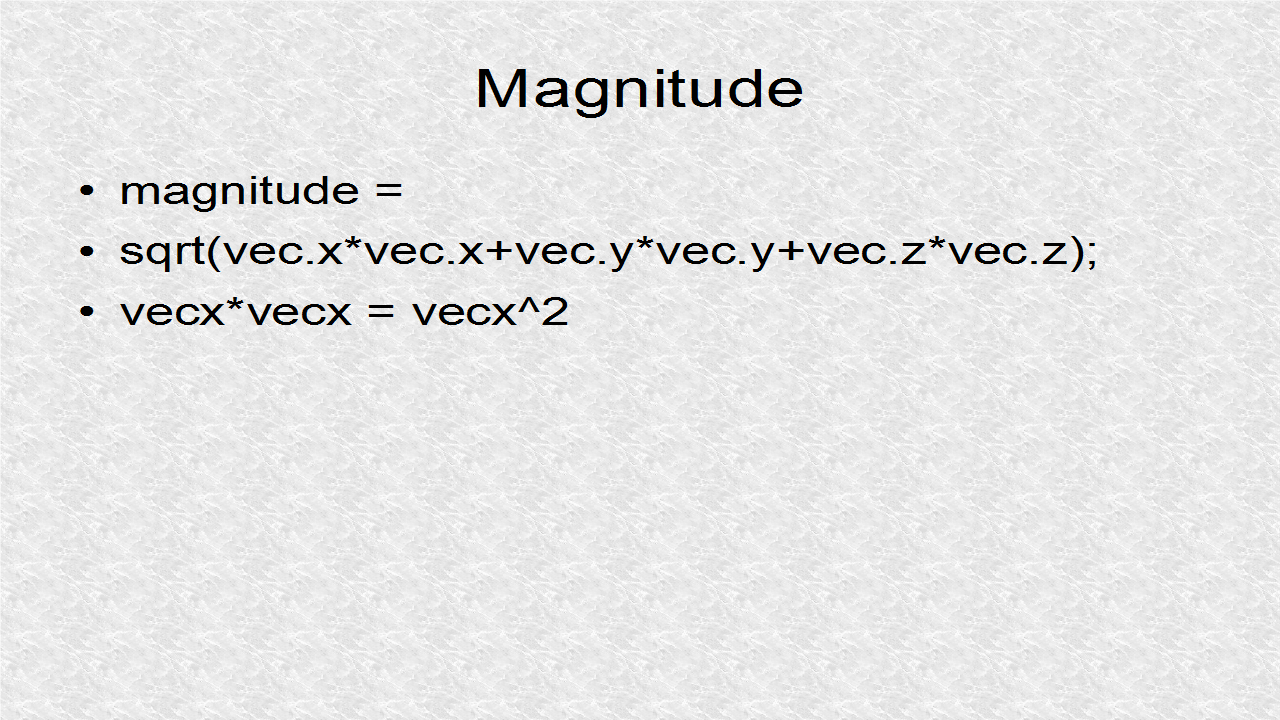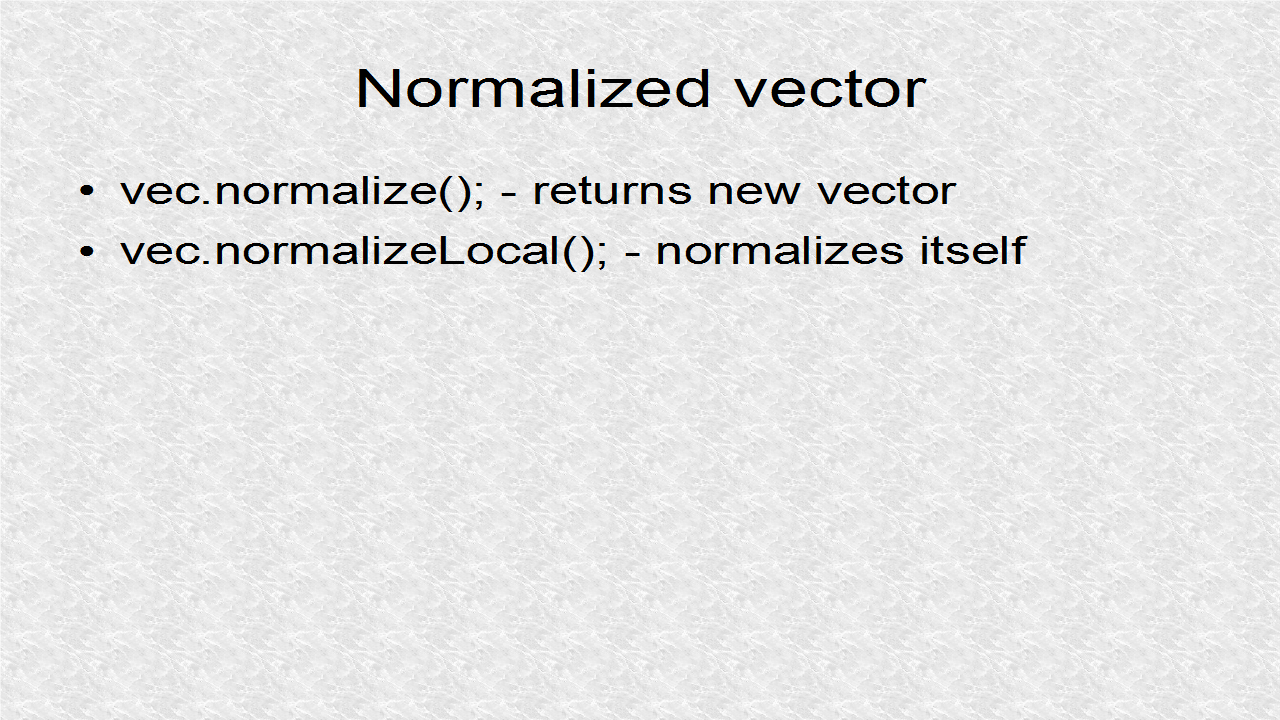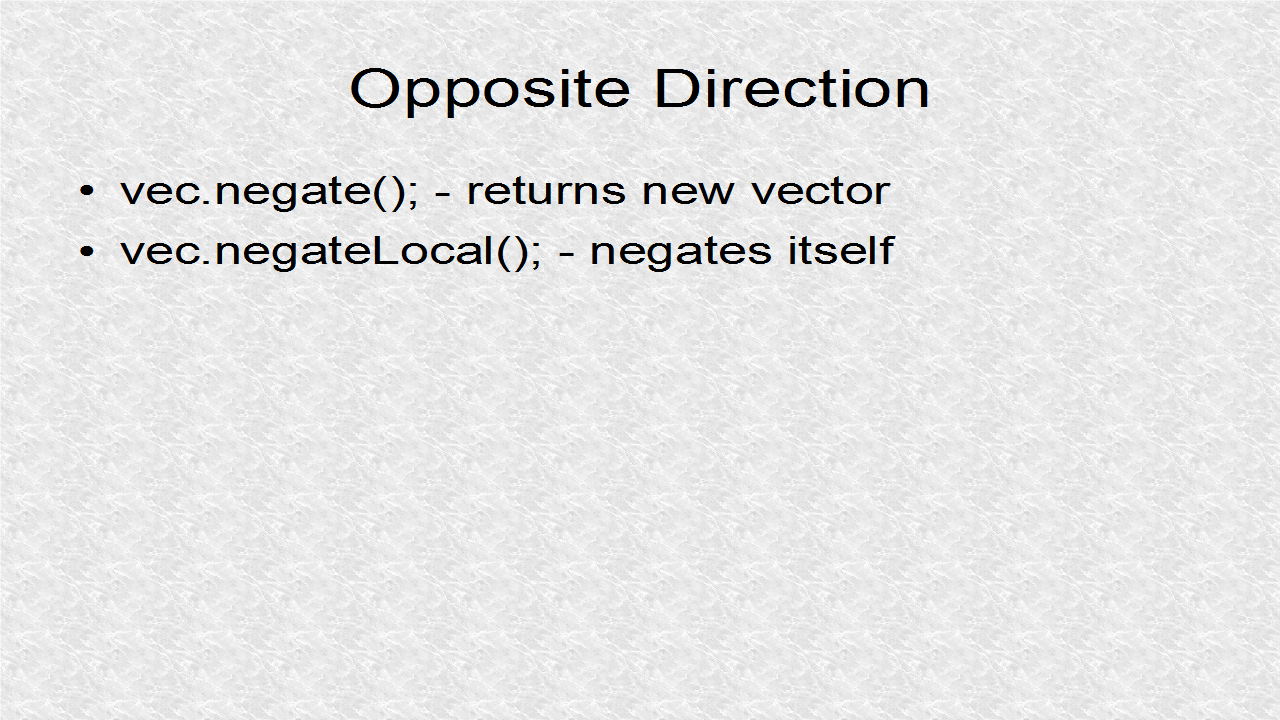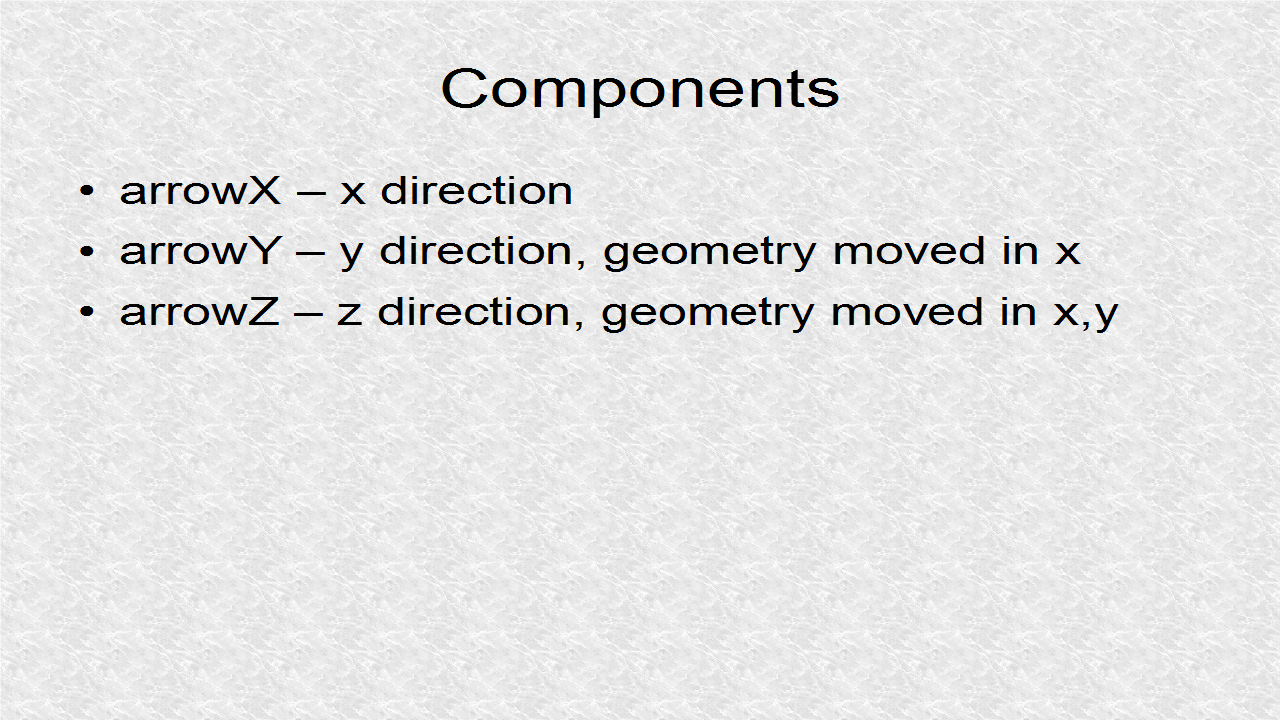RigidBodyControl can either be static or dynamic, depending on mass.
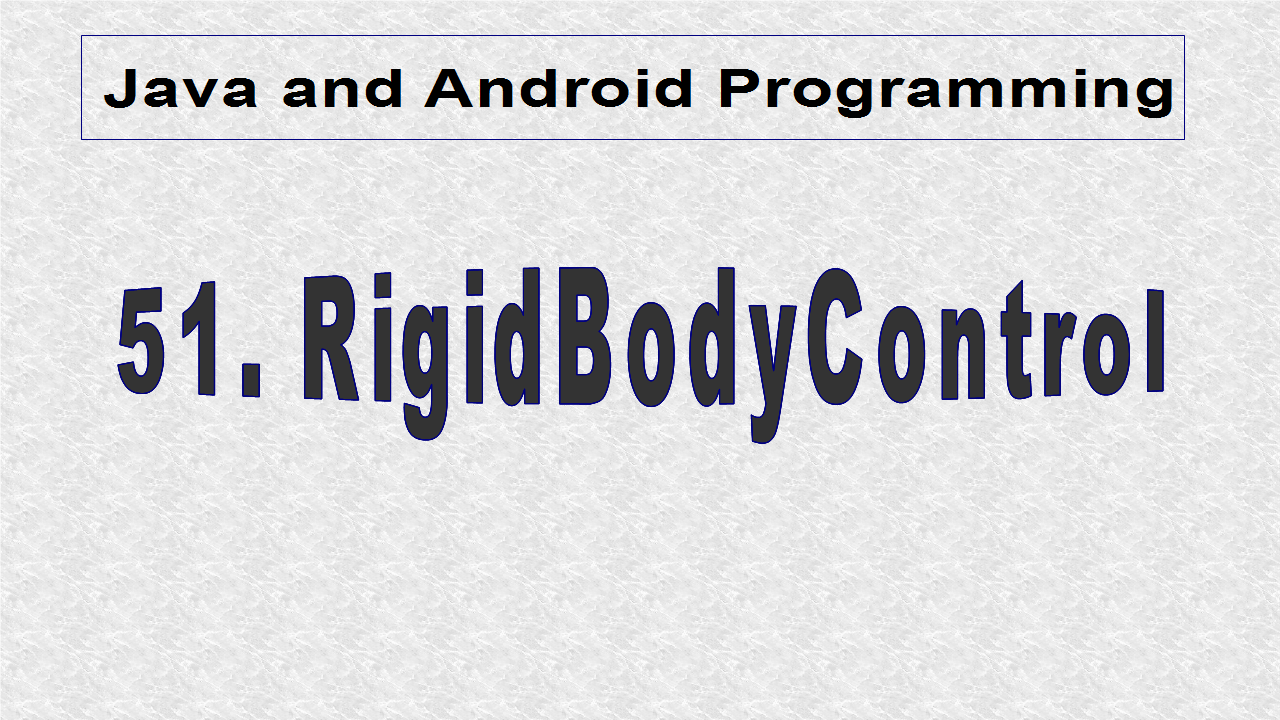
The camera is moved and rotated, so it as y = 20, pointing to origin.
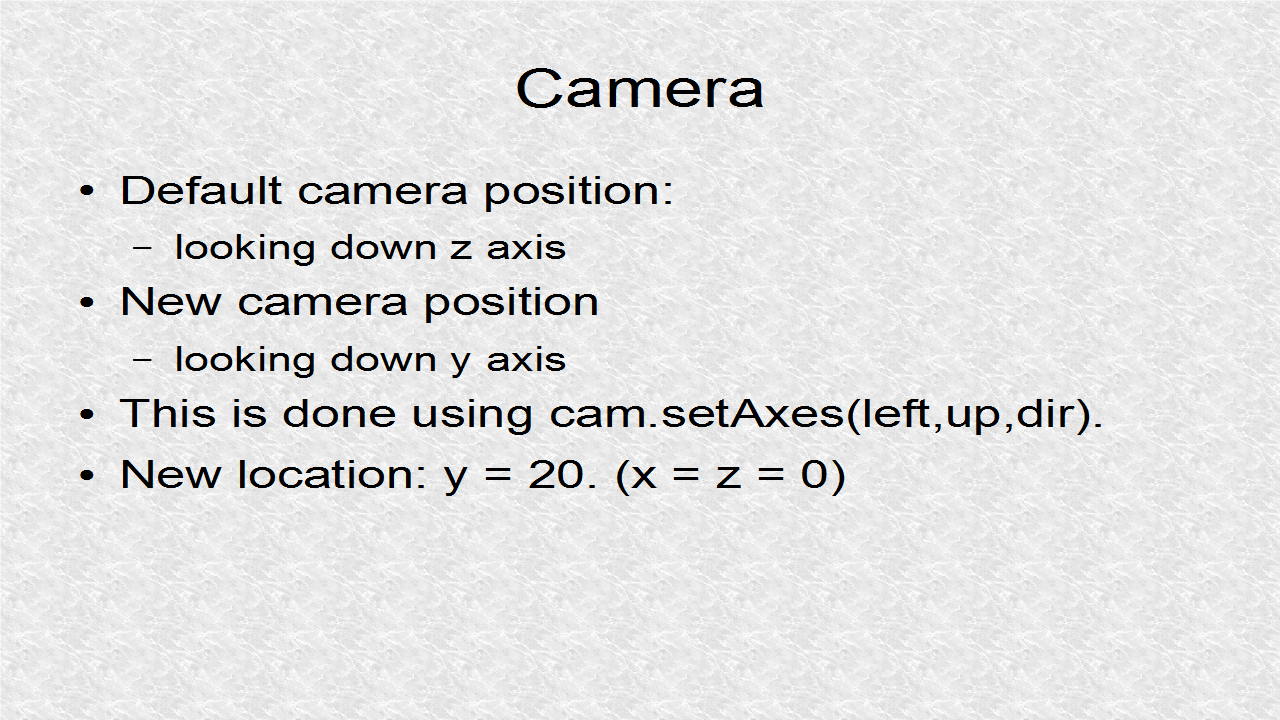
// *** 1. Start (Camera +y looking down y)
cam.setAxes(new Vector3f(-1,0,0), // left
new Vector3f(0,0,-1), // up
new Vector3f(0,-1,0)); // dir
cam.setLocation(new Vector3f(0,20,0)); // above ground
cam.update();
// *** 1. End
The Application has to use BulletAppState object to enable physics.
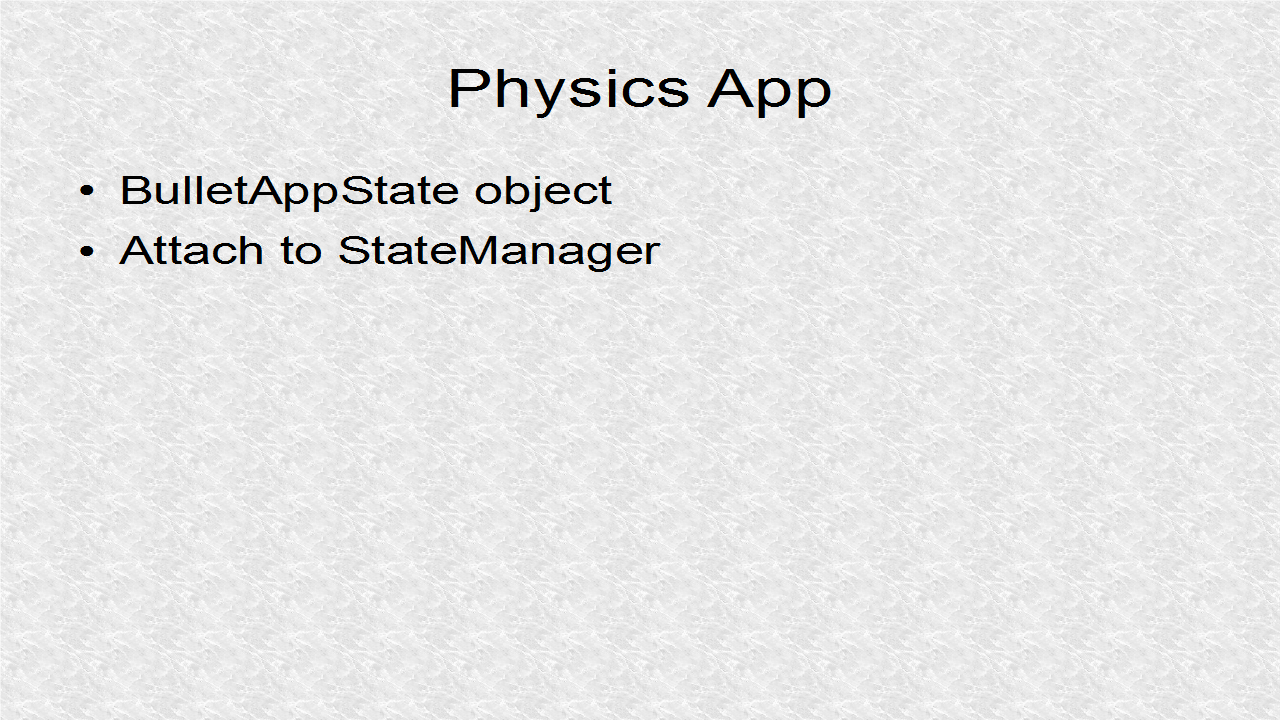
// *** 2. Start (Set Physics)
bulletAppState = new BulletAppState();
stateManager.attach(bulletAppState);
// *** 2. End
The floor is a static Box mesh object.
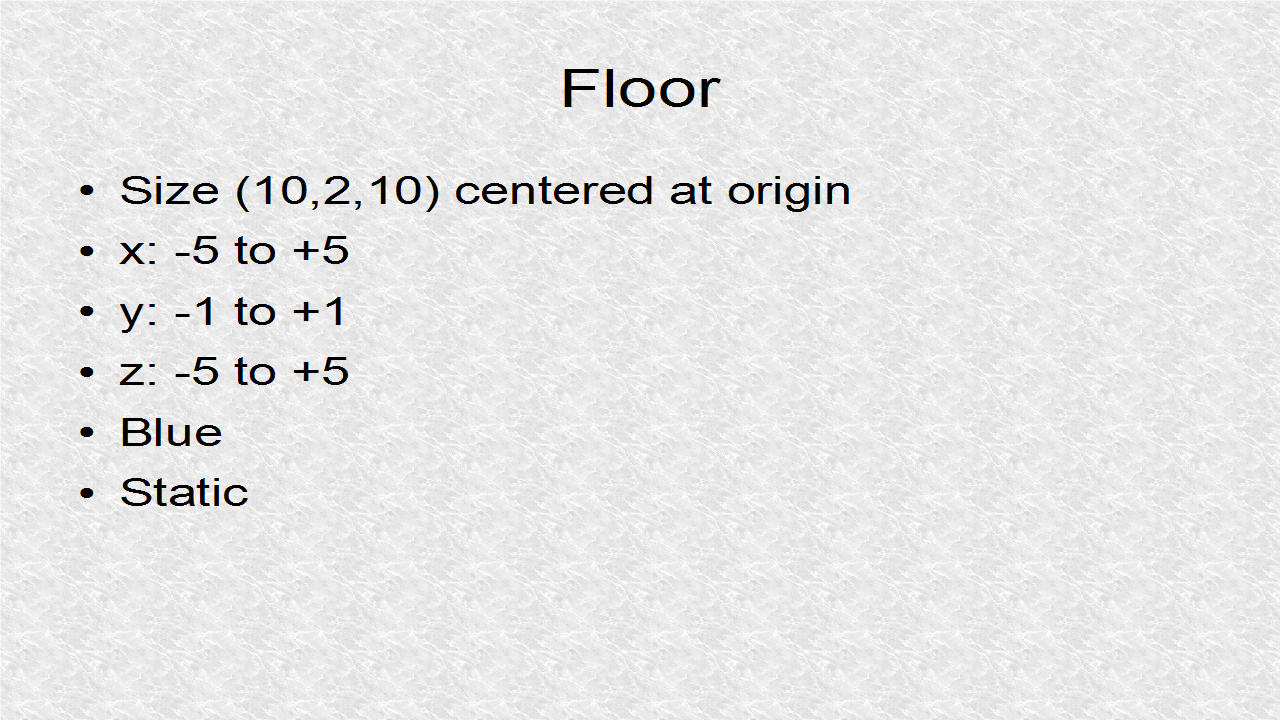
// *** 3. Start (Floor)
Box bFloor = new Box(5, 1, 5);
Geometry geomFloor = new Geometry("Floor", bFloor);
Material matFloor = new Material(assetManager,
"Common/MatDefs/Misc/Unshaded.j3md");
matFloor.setColor("Color", ColorRGBA.Blue);
geomFloor.setMaterial(matFloor);
rootNode.attachChild(geomFloor);
RigidBodyControl floorPhy = new RigidBodyControl(0.0f);
geomFloor.addControl(floorPhy);
bulletAppState.getPhysicsSpace().add(floorPhy);
// *** 3. End
The North Wall is also a static Box mesh object.
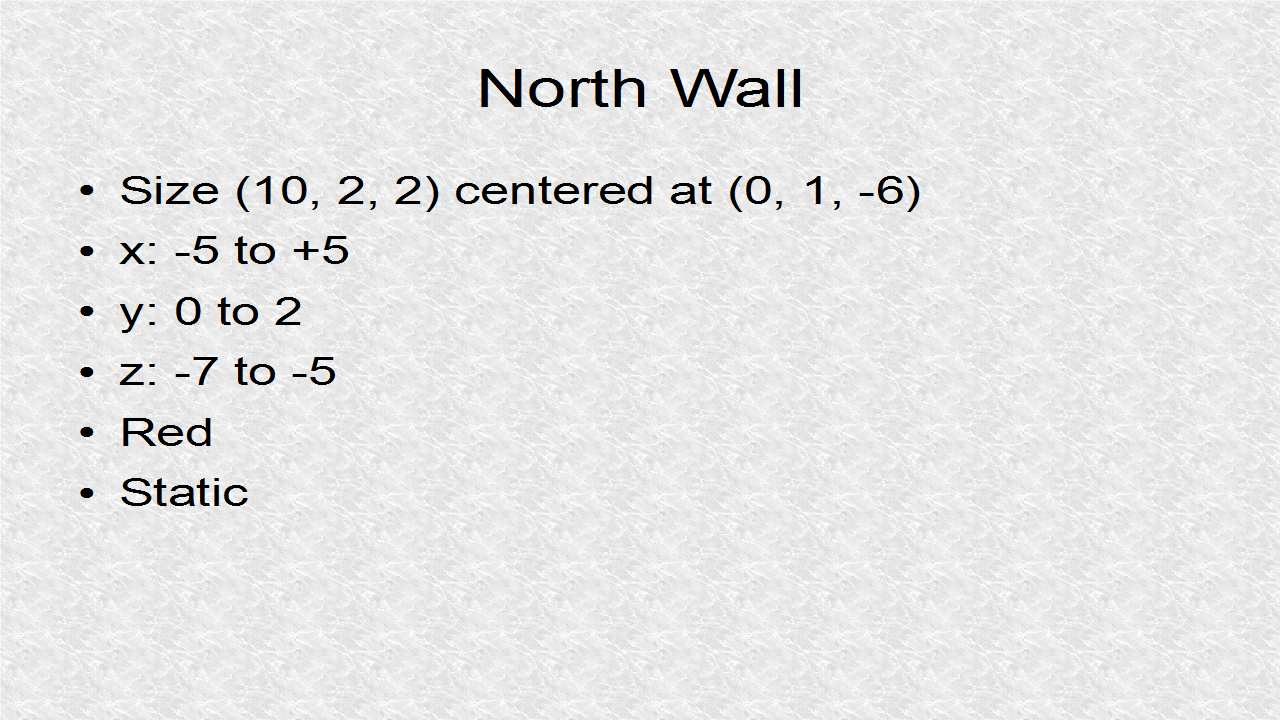
// *** 4. Start (North Wall)
Box bWallN = new Box(5, 1, 1);
Geometry geomWallN = new Geometry("WallN", bWallN);
Material matWallN = new Material(assetManager,
"Common/MatDefs/Misc/Unshaded.j3md");
matWallN.setColor("Color", ColorRGBA.Red);
geomWallN.setLocalTranslation(0, 1, -6);
geomWallN.setMaterial(matWallN);
rootNode.attachChild(geomWallN);
RigidBodyControl wallNPhy = new RigidBodyControl(0.0f);
geomWallN.addControl(wallNPhy);
bulletAppState.getPhysicsSpace().add(wallNPhy);
// *** 4. End
The South Wall is also a static Box mesh object.
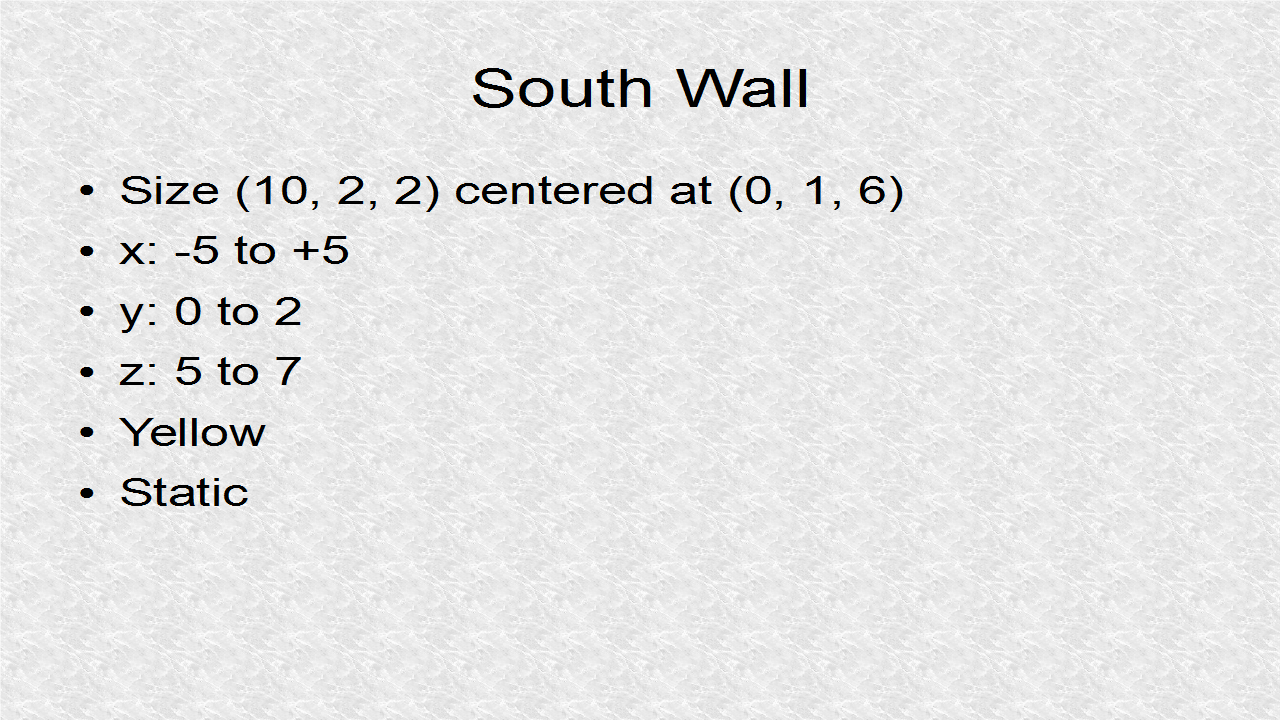
// *** 5. Start (South Wall)
Box bWallS = new Box(5, 1, 1);
Geometry geomWallS = new Geometry("WallS", bWallS);
Material matWallS = new Material(assetManager,
"Common/MatDefs/Misc/Unshaded.j3md");
matWallS.setColor("Color", ColorRGBA.Yellow);
geomWallS.setLocalTranslation(0, 1, 6);
geomWallS.setMaterial(matWallS);
rootNode.attachChild(geomWallS);
RigidBodyControl wallSPhy = new RigidBodyControl(0.0f);
geomWallS.addControl(wallSPhy);
bulletAppState.getPhysicsSpace().add(wallSPhy);
// *** 5. End
The Worth Wall is also a static Box mesh object.
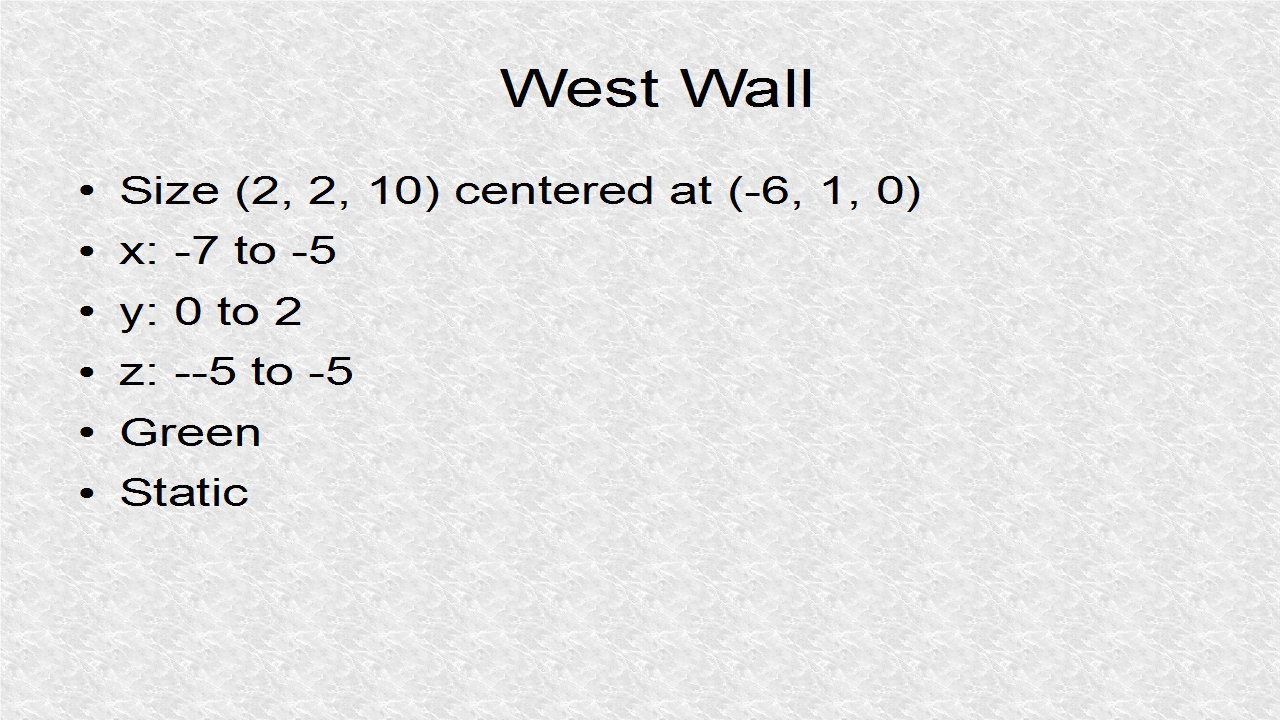
// *** 6. Start (West Wall)
Box bWallW = new Box(1, 1, 5);
Geometry geomWallW = new Geometry("WallW", bWallW);
Material matWallW = new Material(assetManager,
"Common/MatDefs/Misc/Unshaded.j3md");
matWallW.setColor("Color", ColorRGBA.Green);
geomWallW.setLocalTranslation(-6, 1, 0);
geomWallW.setMaterial(matWallW);
rootNode.attachChild(geomWallW);
RigidBodyControl wallWPhy = new RigidBodyControl(0.0f);
geomWallW.addControl(wallWPhy);
bulletAppState.getPhysicsSpace().add(wallWPhy);
// *** 6. End
Finally, the East Wall is also a static Box mesh object.
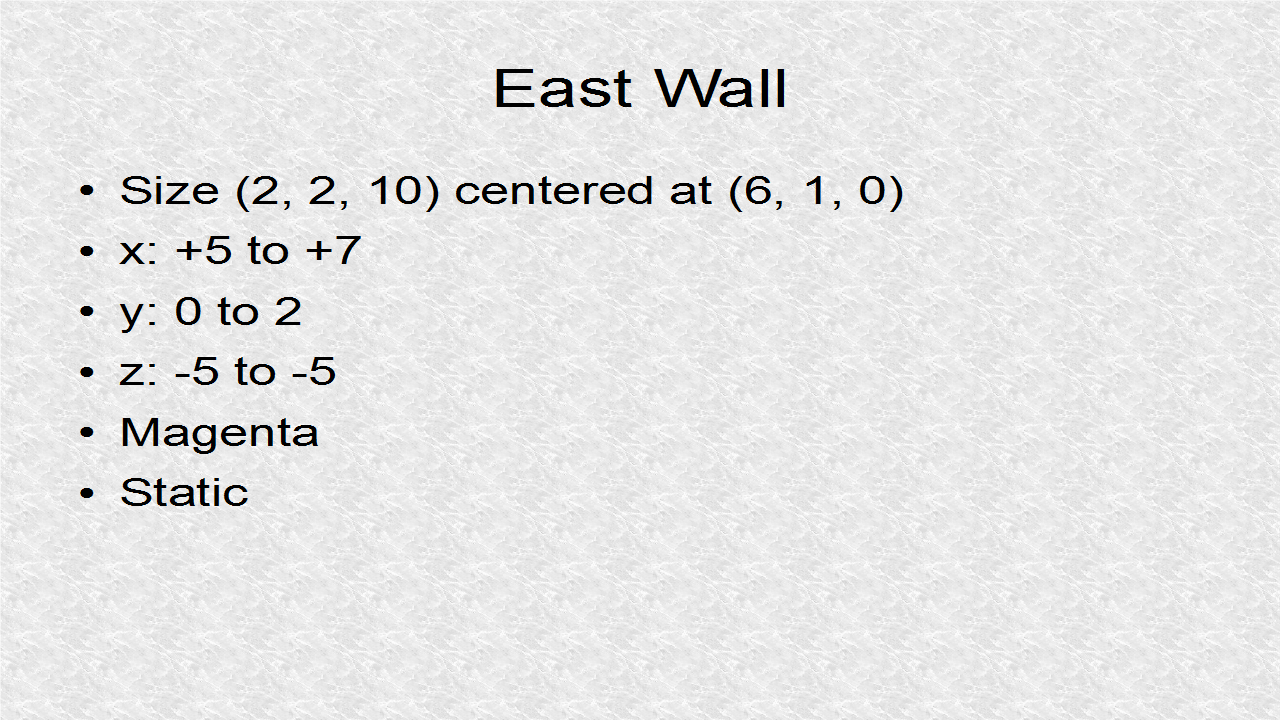
// *** 7. Start (East Wall)
Box bWallE = new Box(1, 1, 5);
Geometry geomWallE = new Geometry("WallE", bWallE);
Material matWallE = new Material(assetManager,
"Common/MatDefs/Misc/Unshaded.j3md");
matWallE.setColor("Color", ColorRGBA.Magenta);
geomWallE.setLocalTranslation(6, 1, 0);
geomWallE.setMaterial(matWallE);
rootNode.attachChild(geomWallE);
RigidBodyControl wallEPhy = new RigidBodyControl(0.0f);
geomWallE.addControl(wallEPhy);
bulletAppState.getPhysicsSpace().add(wallEPhy);
// *** 7. End
ball1 is a Sphere mesh object and is a BetterCharacterControl object.
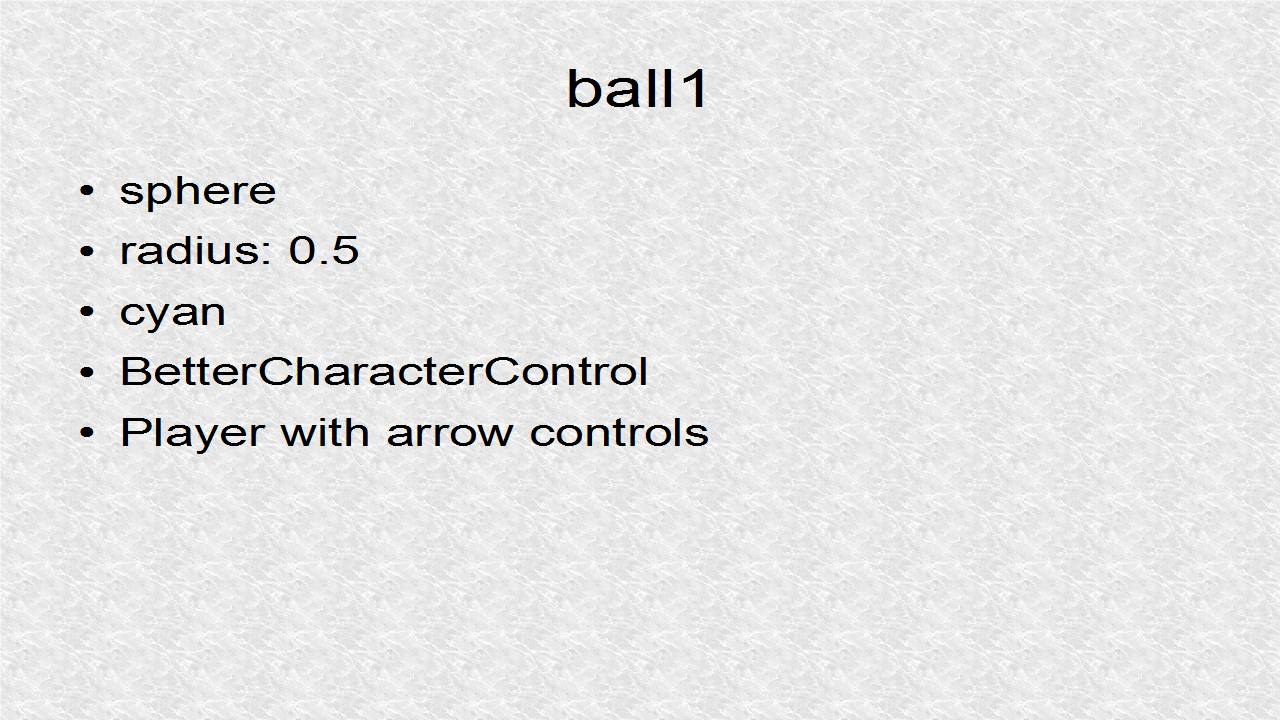
// *** 8. Start (ball1 - Player)
Sphere ball1 = new Sphere (16,16,0.5f);
geomBall1 = new Geometry("ball1", ball1);
Material matBall1 = new Material(assetManager,
"Common/MatDefs/Misc/Unshaded.j3md");
matBall1.setColor("Color", ColorRGBA.Cyan);
geomBall1.setLocalTranslation(0, 2, 0);
geomBall1.setMaterial(matBall1);
rootNode.attachChild(geomBall1);
ball1Phy = new BetterCharacterControl(0.5f,5f,30f);
geomBall1.addControl(ball1Phy);
bulletAppState.getPhysicsSpace().add(ball1Phy);
// *** 8. End
ball2 is a Sphere mesh object. It is RigidBodyControl with nonzero mass.
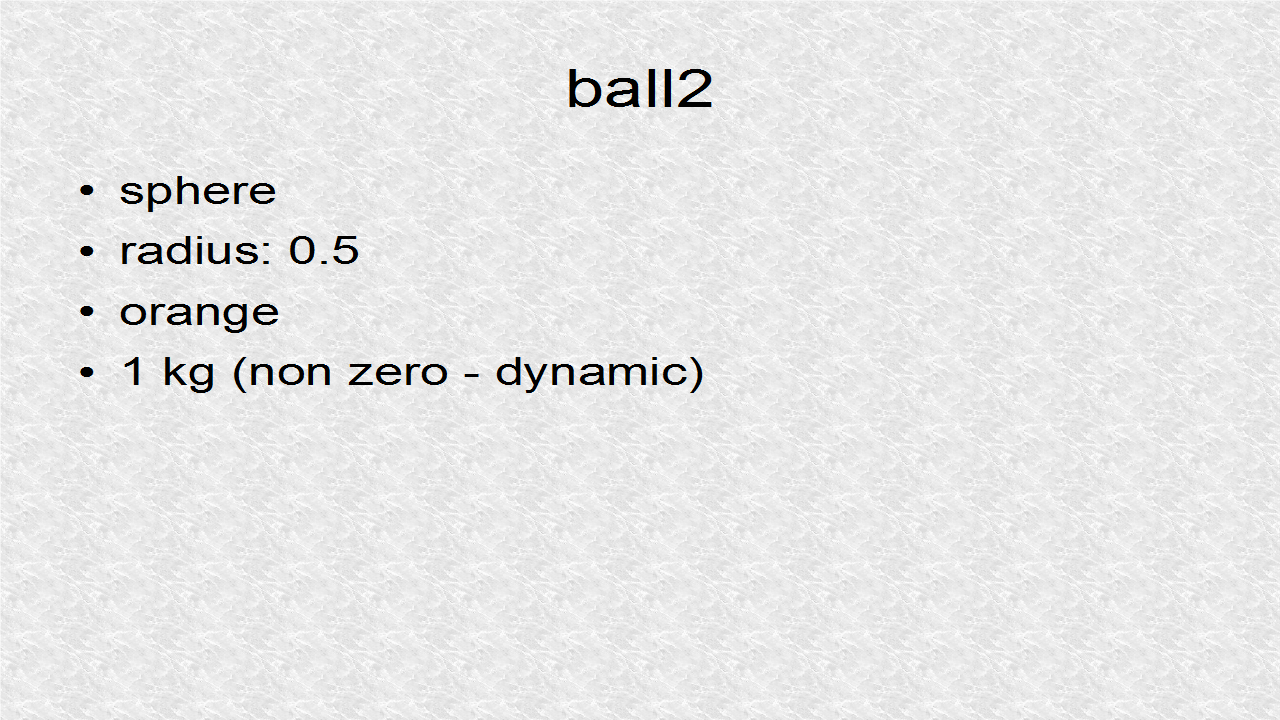
// *** 9. Start (ball2 - Can move)
Sphere ball2 = new Sphere (16,16,0.5f);
Geometry geomBall2 = new Geometry("ball2", ball2);
Material matBall2 = new Material(assetManager,
"Common/MatDefs/Misc/Unshaded.j3md");
matBall2.setColor("Color", ColorRGBA.Orange);
geomBall2.setLocalTranslation(2, 2, 1.5f);
geomBall2.setMaterial(matBall2);
rootNode.attachChild(geomBall2);
RigidBodyControl ball2Phy = new RigidBodyControl(1);
geomBall2.addControl(ball2Phy);
bulletAppState.getPhysicsSpace().add(ball2Phy);
// *** 9. End
ball3 is a Sphere mesh object. It is RigidBodyControl with nonzero mass.
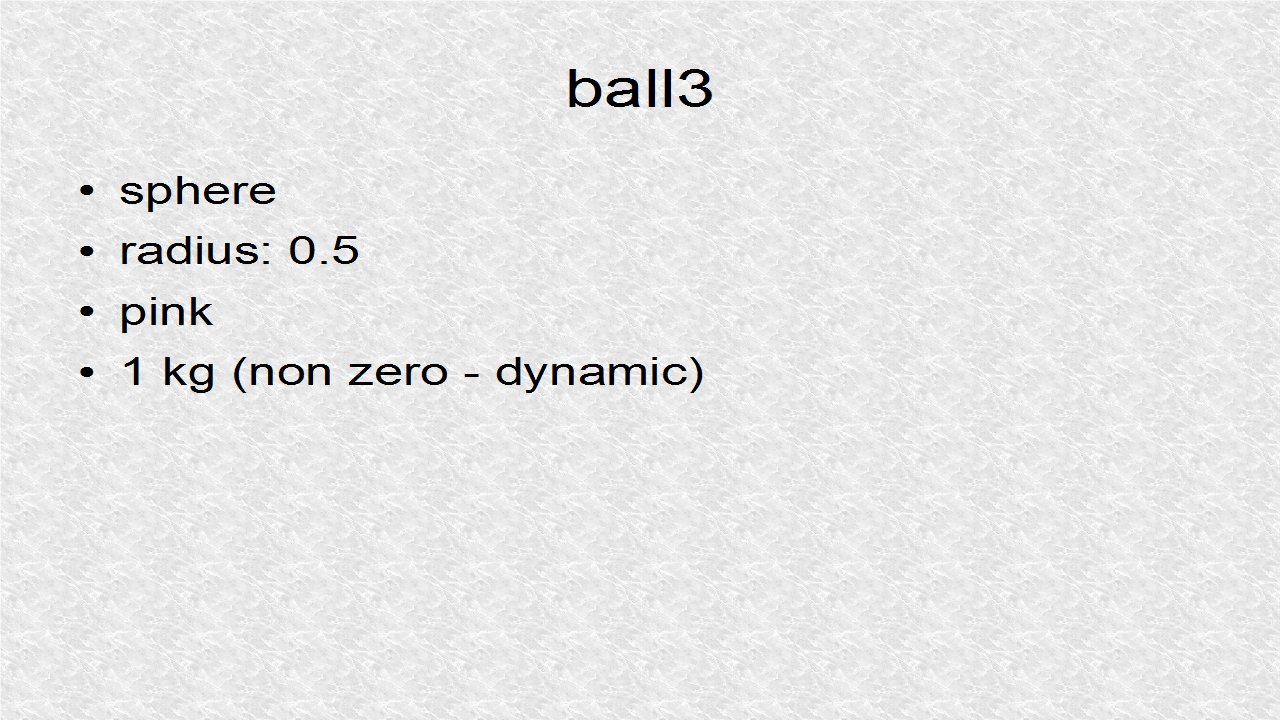
// *** 10. Start (ball2 - Can move)
Sphere ball3 = new Sphere (16,16,0.5f);
Geometry geomBall3 = new Geometry("ball3", ball3);
Material matBall3 = new Material(assetManager,
"Common/MatDefs/Misc/Unshaded.j3md");
matBall3.setColor("Color", ColorRGBA.Pink);
geomBall3.setLocalTranslation(-2, 2, -1.5f);
geomBall3.setMaterial(matBall3);
rootNode.attachChild(geomBall3);
RigidBodyControl ball3Phy = new RigidBodyControl(1);
geomBall3.addControl(ball3Phy);
bulletAppState.getPhysicsSpace().add(ball3Phy);
// *** 10. End
// JMonkey51.java
package mygame;
import com.jme3.app.SimpleApplication;
import com.jme3.bullet.BulletAppState;
import com.jme3.bullet.control.BetterCharacterControl;
import com.jme3.bullet.control.RigidBodyControl;
import com.jme3.input.KeyInput;
import com.jme3.input.controls.ActionListener;
import com.jme3.input.controls.KeyTrigger;
import com.jme3.material.Material;
import com.jme3.math.ColorRGBA;
import com.jme3.math.Vector3f;
import com.jme3.renderer.RenderManager;
import com.jme3.scene.Geometry;
import com.jme3.scene.shape.Box;
import com.jme3.scene.shape.Sphere;
public class JMonkey51 extends SimpleApplication {
public static void main(String[] args) {
JMonkey51 app = new JMonkey51();
app.start();
}
Geometry geomBall1; // Player Geometry
private BulletAppState bulletAppState; // Physics
private BetterCharacterControl ball1Phy; // Player
private Vector3f walkDirection = new Vector3f();
private boolean left = false,
right = false, up = false, down = false;
@Override
public void simpleInitApp() {
flyCam.setEnabled(false);
viewPort.setBackgroundColor(ColorRGBA.LightGray);
setDisplayFps(false);
setDisplayStatView(false);
// *** 1. Start (Camera +y looking down y)
cam.setAxes(new Vector3f(-1,0,0), // left
new Vector3f(0,0,-1), // up
new Vector3f(0,-1,0)); // dir
cam.setLocation(new Vector3f(0,20,0)); // above ground
cam.update();
// *** 1. End
// *** 2. Start (Set Physics)
bulletAppState = new BulletAppState();
stateManager.attach(bulletAppState);
// *** 2. End
// *** 3. Start (Floor)
Box bFloor = new Box(5, 1, 5);
Geometry geomFloor = new Geometry("Floor", bFloor);
Material matFloor = new Material(assetManager,
"Common/MatDefs/Misc/Unshaded.j3md");
matFloor.setColor("Color", ColorRGBA.Blue);
geomFloor.setMaterial(matFloor);
rootNode.attachChild(geomFloor);
RigidBodyControl floorPhy = new RigidBodyControl(0.0f);
geomFloor.addControl(floorPhy);
bulletAppState.getPhysicsSpace().add(floorPhy);
// *** 3. End
// *** 4. Start (North Wall)
Box bWallN = new Box(5, 1, 1);
Geometry geomWallN = new Geometry("WallN", bWallN);
Material matWallN = new Material(assetManager,
"Common/MatDefs/Misc/Unshaded.j3md");
matWallN.setColor("Color", ColorRGBA.Red);
geomWallN.setLocalTranslation(0, 1, -6);
geomWallN.setMaterial(matWallN);
rootNode.attachChild(geomWallN);
RigidBodyControl wallNPhy = new RigidBodyControl(0.0f);
geomWallN.addControl(wallNPhy);
bulletAppState.getPhysicsSpace().add(wallNPhy);
// *** 4. End
// *** 5. Start (South Wall)
Box bWallS = new Box(5, 1, 1);
Geometry geomWallS = new Geometry("WallS", bWallS);
Material matWallS = new Material(assetManager,
"Common/MatDefs/Misc/Unshaded.j3md");
matWallS.setColor("Color", ColorRGBA.Yellow);
geomWallS.setLocalTranslation(0, 1, 6);
geomWallS.setMaterial(matWallS);
rootNode.attachChild(geomWallS);
RigidBodyControl wallSPhy = new RigidBodyControl(0.0f);
geomWallS.addControl(wallSPhy);
bulletAppState.getPhysicsSpace().add(wallSPhy);
// *** 5. End
// *** 6. Start (West Wall)
Box bWallW = new Box(1, 1, 5);
Geometry geomWallW = new Geometry("WallW", bWallW);
Material matWallW = new Material(assetManager,
"Common/MatDefs/Misc/Unshaded.j3md");
matWallW.setColor("Color", ColorRGBA.Green);
geomWallW.setLocalTranslation(-6, 1, 0);
geomWallW.setMaterial(matWallW);
rootNode.attachChild(geomWallW);
RigidBodyControl wallWPhy = new RigidBodyControl(0.0f);
geomWallW.addControl(wallWPhy);
bulletAppState.getPhysicsSpace().add(wallWPhy);
// *** 6. End
// *** 7. Start (East Wall)
Box bWallE = new Box(1, 1, 5);
Geometry geomWallE = new Geometry("WallE", bWallE);
Material matWallE = new Material(assetManager,
"Common/MatDefs/Misc/Unshaded.j3md");
matWallE.setColor("Color", ColorRGBA.Magenta);
geomWallE.setLocalTranslation(6, 1, 0);
geomWallE.setMaterial(matWallE);
rootNode.attachChild(geomWallE);
RigidBodyControl wallEPhy = new RigidBodyControl(0.0f);
geomWallE.addControl(wallEPhy);
bulletAppState.getPhysicsSpace().add(wallEPhy);
// *** 7. End
// *** 8. Start (ball1 - Player)
Sphere ball1 = new Sphere (16,16,0.5f);
geomBall1 = new Geometry("ball1", ball1);
Material matBall1 = new Material(assetManager,
"Common/MatDefs/Misc/Unshaded.j3md");
matBall1.setColor("Color", ColorRGBA.Cyan);
geomBall1.setLocalTranslation(0, 2, 0);
geomBall1.setMaterial(matBall1);
rootNode.attachChild(geomBall1);
ball1Phy = new BetterCharacterControl(0.5f,5f,30f);
geomBall1.addControl(ball1Phy);
bulletAppState.getPhysicsSpace().add(ball1Phy);
// *** 8. End
// *** 9. Start (ball2 - Can move)
Sphere ball2 = new Sphere (16,16,0.5f);
Geometry geomBall2 = new Geometry("ball2", ball2);
Material matBall2 = new Material(assetManager,
"Common/MatDefs/Misc/Unshaded.j3md");
matBall2.setColor("Color", ColorRGBA.Orange);
geomBall2.setLocalTranslation(2, 2, 1.5f);
geomBall2.setMaterial(matBall2);
rootNode.attachChild(geomBall2);
RigidBodyControl ball2Phy = new RigidBodyControl(1);
geomBall2.addControl(ball2Phy);
bulletAppState.getPhysicsSpace().add(ball2Phy);
// *** 9. End
// *** 10. Start (ball2 - Can move)
Sphere ball3 = new Sphere (16,16,0.5f);
Geometry geomBall3 = new Geometry("ball3", ball3);
Material matBall3 = new Material(assetManager,
"Common/MatDefs/Misc/Unshaded.j3md");
matBall3.setColor("Color", ColorRGBA.Pink);
geomBall3.setLocalTranslation(-2, 2, -1.5f);
geomBall3.setMaterial(matBall3);
rootNode.attachChild(geomBall3);
RigidBodyControl ball3Phy = new RigidBodyControl(1);
geomBall3.addControl(ball3Phy);
bulletAppState.getPhysicsSpace().add(ball3Phy);
// *** 10. End
setupKeys();
}
private void setupKeys() {
inputManager.addMapping("Left",
new KeyTrigger(KeyInput.KEY_LEFT));
inputManager.addMapping("Right",
new KeyTrigger(KeyInput.KEY_RIGHT));
inputManager.addMapping("Up",
new KeyTrigger(KeyInput.KEY_UP));
inputManager.addMapping("Down",
new KeyTrigger(KeyInput.KEY_DOWN));
inputManager.addListener(actionListener,
"Left","Right","Up","Down");
}
private ActionListener actionListener = new ActionListener() {
public void onAction(String binding, boolean isPressed, float tpf) {
if (binding.equals("Left")) {
left = isPressed;
} else if (binding.equals("Right")) {
right= isPressed;
} else if (binding.equals("Up")) {
up = isPressed;
} else if (binding.equals("Down")) {
down = isPressed;
}
}
};
@Override
public void simpleUpdate(float tpf) {
walkDirection.set(0, 0, 0);
if (left) {
walkDirection.addLocal(-10f,0,0);
} else if (right) {
walkDirection.addLocal(10f,0,0);
}
if (up) {
walkDirection.addLocal(0,0,-10f);
} else if (down) {
walkDirection.addLocal(0,0,+10f);
}
ball1Phy.setWalkDirection(walkDirection);
}
@Override
public void simpleRender(RenderManager rm) {
}
}
Output:












